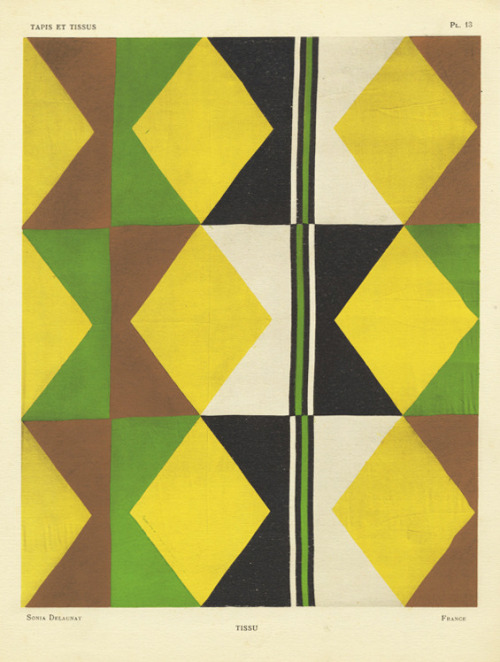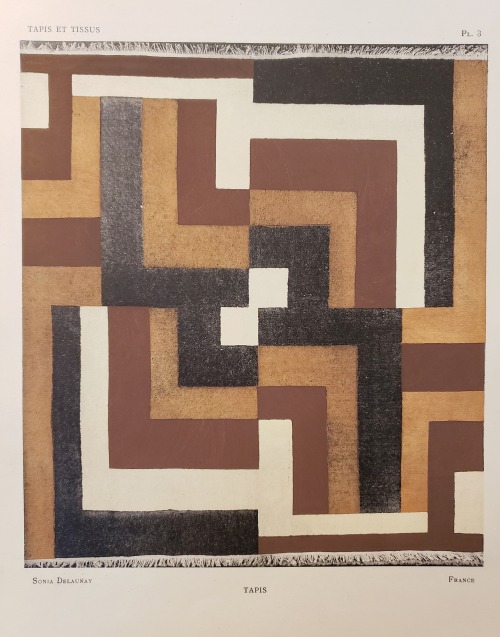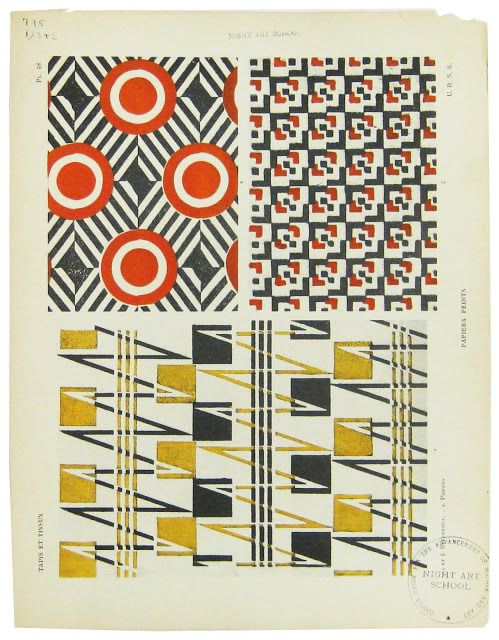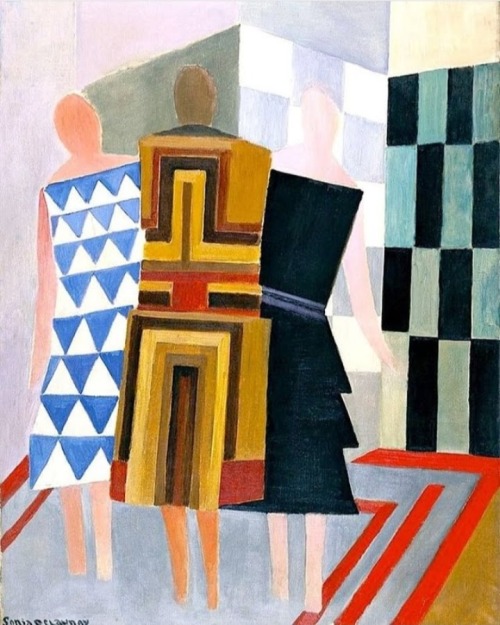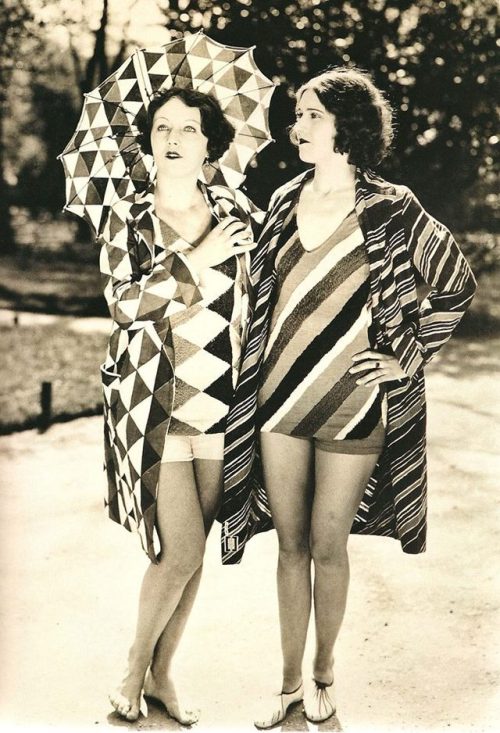#sonia delaunay

Rhythme, 1938 by Ukranian French artist Sonia Delaunay

OPEN BOOK NEXT TO BOX (ABOVE)
It is always a wonderful feeling when a book is complete. However long it has taken from beginning to end, there is always a sense of achievement. The work doesn’t stop there though, it needed to be photographed and I still had my blog post to write about it.
It turns out that this blog post has been rather a long one! The fact that it is such an interesting project to have worked on with the recreation of such an spectacular original and all the background research that Kitty Maryatt put in to realising it, alongside the point that I had never worked on this structure of binding before, and also the editing of such a lot of images and stages to write about has turned this in to a five part post.
The book is also on my website here.
OPEN BOOK COVERS (BELOW)

But what do the covers read? I took text from near the beginning of the poem for the back cover:
I was in my adolescence at the time
Scarcely sixteen and already I no longer remembered my childhood
I was 16,000 leagues from my birthplace
I was in Moscow, in the city of a thousand and three belfries and seven railroad stations
And they weren’t enough for me, the seven railroad stations and the thousand and three towers
For my adolescence was so blazing and so mad
That my heart burned in turns as the temple of Epheseus, or as Red Square in Moscow
When the sun sinks.
And my eyes shone upon the ancient routes
And I was already such a bad poet
That I didn’t know how to go all the way to the end.
.
The Kremlin was like an immense Tatar cake
Crusted with gold,
With great almonds of cathedrals all done in white
And the honeyed gold of the bells…
.
An old monk was reading to me the legend of Novgorod
I was thirsty
And I was deciphering…
And for the front cover, a section towards the end. This was a rather apt section of text to choose given it included the words “rouge”, “vert”, “multicolores”, “jaune” and “d’or” - how appropriate for a colourful book!
O Paris
Large glowing hearth with the crossed pokers of your streets and your old homes that hunch over warming themselves
Like forefathers
And here are the posters, red and green multicoloured as my brief yellow past
Yellow the proud colour of French novels sold abroad.
.
I love to squeeze into moving buses in big cities
Those of the Saint-Germain-Montmartre line bring me to the assault of the Hill
The motors bellow like golden bulls
The bovine twilight grazes the Sacre Cœur
O Paris
Central station last stop of desire crossroads of unrest
Only the merchants of colour still have a little bit of light on their doors
The “International Company of Sleeping Cars and Europeans Express Trains” has sent me their brochure
It is the most beautiful church in the world
OPEN BOOK IN FRONT OF OPEN BOX (BELOW)
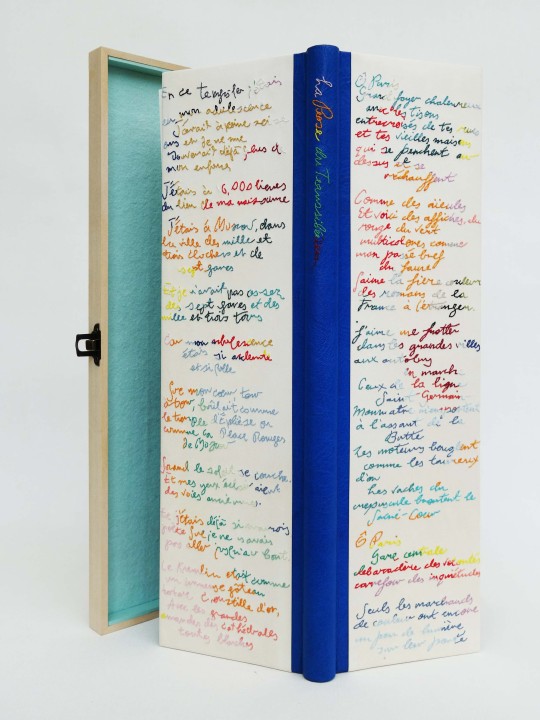
FRONT COVER AND TEXT BLOCK EDGE (BELOW)
Although in the original, due to how the text block was folded, neither the text or the imagery could be seen until the book was completely unfolded, this was not the case for my binding. I was really thrilled once it was finished to see how well the coloured stitching harmonised with the strips of colour on the folded edges of the pages.

DETAIL OF BOOK ON TOP OF BOX (BELOW)
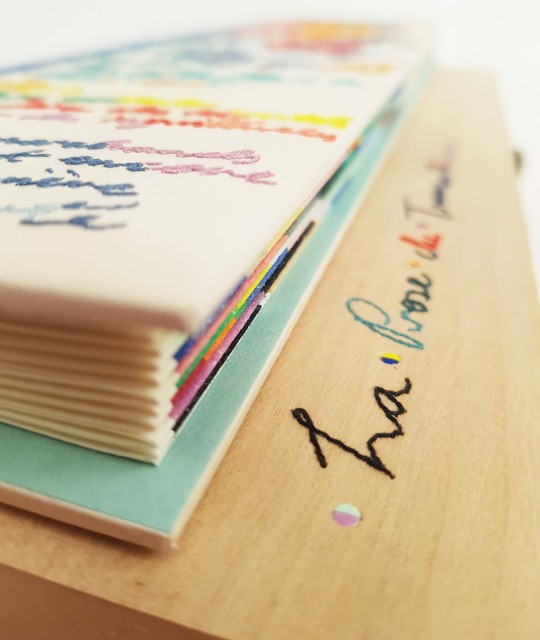
BOX LID (BELOW)
I really liked the fact that the box remained so simple, with just the title added on the top. I didn’t want to take away from the intricate a coloured embroidery of the cover that popped out as you opened the lid.

BLAISE CENDRARS SIGNATURE INSIDE SPINE (BELOW)
Blaise Cendrar’s signature was placed so that it would be a little added extra surprise as the book was opened. With embroidering it inside the spine it is hidden behind the concertina when the book is closed.
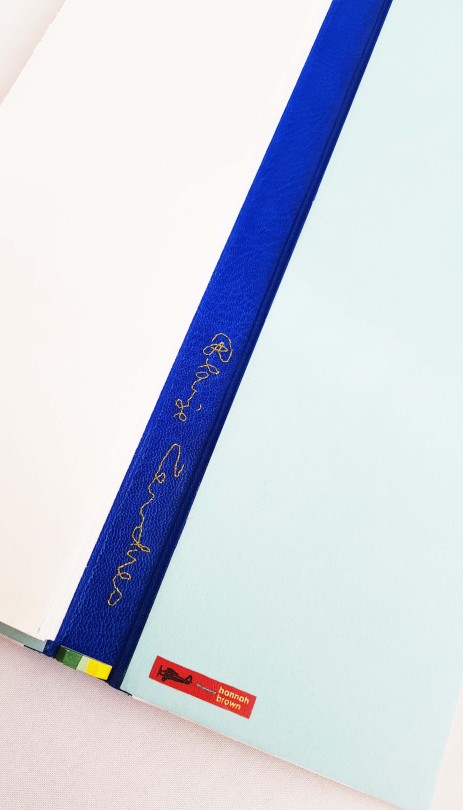
DETAIL OF OPEN CONCERTINA
The wonderful colours of the pochoir spill out as the concertina is unfolded. I was really pleased with how well the pochoir-covered end-caps worked as an extra design element of the binding.

SPINE TITLE (BELOW)
The title was embroidered, thankfully without any spelling mistakes (see below for details of my near disaster!).
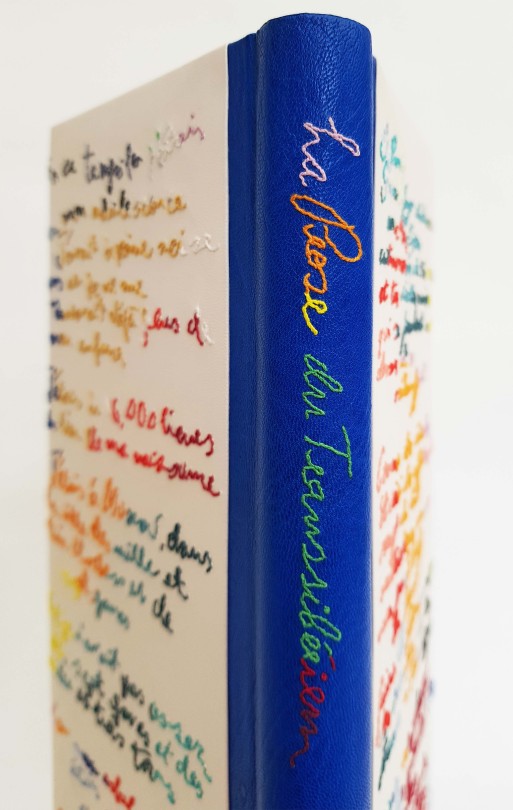
EMBROIDERY DETAIL (BELOW)
From pink, to yellow, to green, to red, to blue and on and on, this truly was a book of multicolour.

THE OUTER BOX (BELOW)
The wooden box I had made was further housed in an outer conservation box. This was partly to protect it, and also so that the small accompanying concertina pamphlet that Kitty Maryatt had produced explaining about the project could live with the binding. This little booklet had a section made for it in the outer box so it could sit below the wooden box.
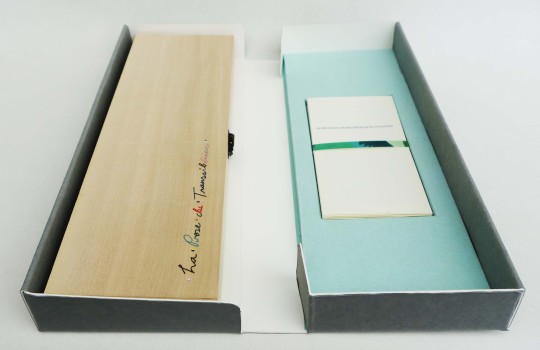
THE SAMPLE BOARD/BOOK
I have made reference in previous parts of this blog post to the sample board/book that I worked on ahead of the actual binding, I finish with some photos of this. I chose a darker blue goatskin for this spine with gold thread to embroider the title, this changed on the actual binding as I felt the dark blue didn’t match the pochoir.
I didn’t have quite enough vellum to cover the back board entirely so I pieced two bits together and masked the joint with a strip of the leftover pochoir.

SAMPLE BOARD/BOOK COVER EMBROIDERY
I embroidered the sample with writing at and angle, however decided to change this on the actual binding working horizontally. Thankfully, I had asked in advance whether it was okay to post images of some of my work in progress online whilst working on this project, both Kitty Maryatt and Neale Albert agreed. I was very pleased that this was the case as a French friend of mine spotted a spelling error on the sample book! Rather than “La Prose de Transsbérien”, it should have been “La Prose du Transsbérien”, another good reason for doing sample boards I guess - phew!

THE OPEN CONCERTINA OF THE SAMPLE BOARD/BOOK
The book was made so that when closed, the width and height were the same dimensions as my sample boards. Although of course it is thicker than a sample board, it can still sit in the same box as them in a wider slot.
This mini book is also going to have a second purpose, I have been meaning for a long while to make an index for my sample boards. Given this bookis a sample board, and will therefore be in the box with them, I intend to use it’s pages to index all the other boards.
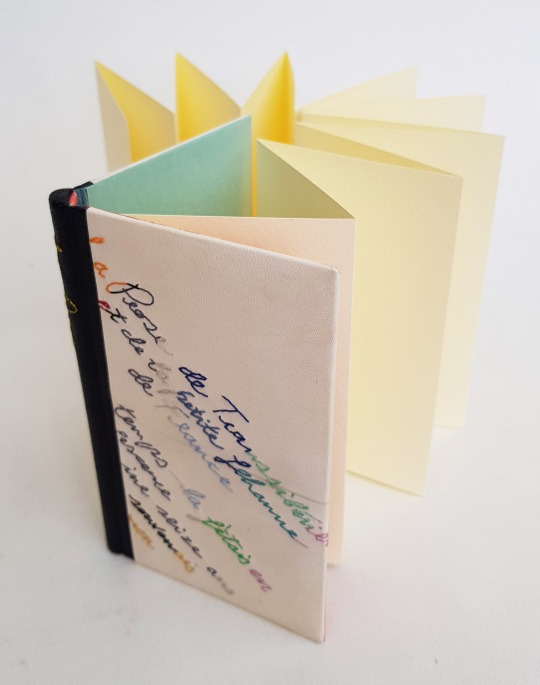
SAMPLE BOARD CONCERTINA PAGES
The front and back doublures of the sample book are different colours, initially I thought I would go for red doublures but in the end opted for pale blue to match the first spread of the concertina when opened.

BLAISE CENDRARS SIGNATURE ON INNER SPINE
Blaise Cendrar’s signature also appears on the sample book in red thread. This is sample number 54 in my ever-growing series.
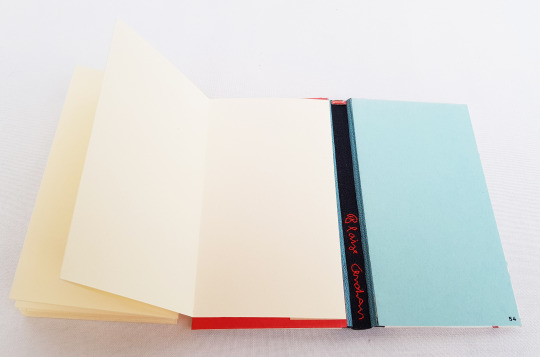
The completed binding is now safely in New York. It is due to be shipped on to San Francisco to take part in the following exhibition alongside some other absolutely wonderful bindings of La Prose by other binders.
EXHIBITION at the San Francisco Center for the Book
TITLE: Drop Dead Gorgeous: Fine Bindings of La Prose du Transsibérien Re-creation
DATES: September 6 to October 6, 2019
OPENING RECEPTION: Friday, September 6, 2019, 6:00–8:00 pm
LOCATION: San Francisco Center for the Book, 375 Rhode Island Street, San Francisco, CA.
The remarkable book by poet Blaise Cendrars and artist Sonia Delaunay, La Prose du Transsibérien et de la petite Jehanne de France, was produced by letterpress and pochoir in 1913. It was a landmark achievement for its time with its unprecedented format, avant-garde typography and abstract imagery, and remains vibrant and modern today.
Kitty Maryatt of Two Hands Press has been researching the production of La Prose du Transsibérien since 2012. In 2018, she debuted a new edition of 150 copies, which faithfully incorporates techniques and methods used in the original. At the same time, Maryatt and her underwriters commissioned fine bindings by notable design binders from around the world. These bindings, along with Maryatt’s La Prose du Transsibérien Re-Creation, have resulted in a traveling exhibition titled Drop Dead Gorgeous: Fine Bindings of La Prose du Transsibérien Re-creation.
Debuting in San Francisco, the exhibition will feature the work of twenty-two design binders, including Don Glaister, Monique Lallier, Midori Kunikata-Cockram and Kathy Abbott. Tools, materials, and supplemental material used in the creation of Maryatt’s edition of La Prose will also be on display. Upon closing in San Francisco in October, the exhibition travels to additional venues in the United States, Canada and England.
DOCUMENTARY SHOWING
TITLE: The Re-creation of a Masterpiece: La Prose du Transsibérien. Documentary by Rosylyn Rhee. Los Angeles, 2019.
DATE: Friday, October 4, 2019, 6:00–8:00 pm
LOCATION: San Francisco Center for the Book, 375 Rhode Island Street, San Francisco, CA.
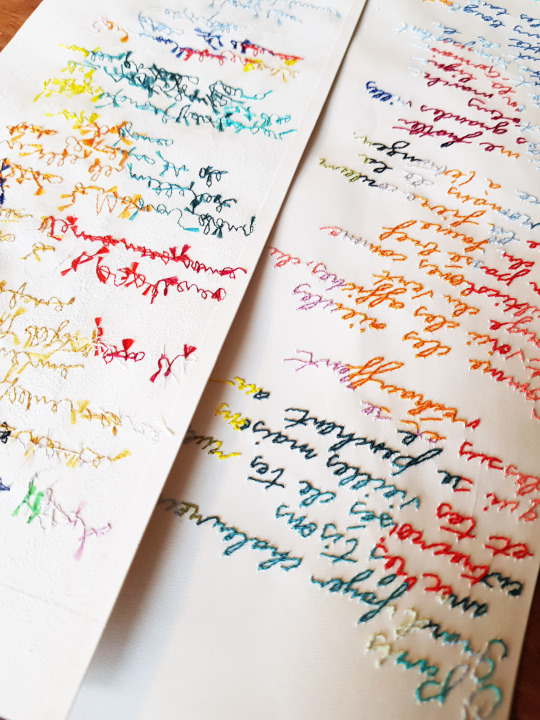
The day I completed the embroidery was a great feeling, but the next stage was getting the vellum stuck down onto the boards which was rather daunting. I always like to capture a photo of the reverse of the covering material before I stick it down, as it tells a story of how the front came to be, in some ways it is more interesting than what is on the surface!
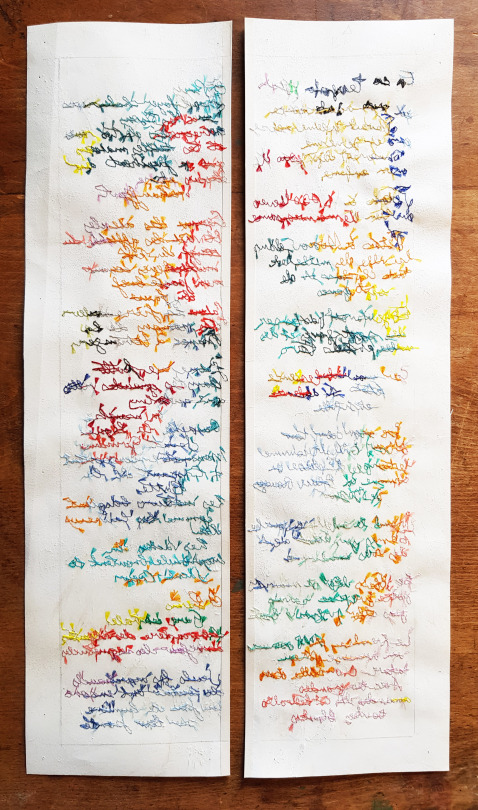
I had experimented with gluing the vellum to stick to the sample book so I knew that the best adhesive was going to be a mixture of PVA glue and paste. I mixed this up in my roller tray and used a roller to apply it (I would usually use a paste brush for pasting out leather, but I found that it was best to use a roller for the vellum). The turn-ins were given a bit more PVA before turning them around the edges of the boards. The whole thing was lightly pressed under a weight and left to dry - I regularly changed the blotting papers to draw the moisture out.

I was really thrilled to see once dry that the vellum had gone down well. I gave it a good extra rub down through silicone release paper just to level out the embroidery threads.
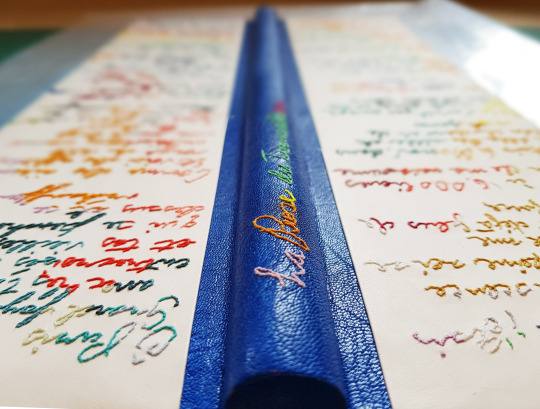
Once the vellum on the cover was dry it was time to work on the inside of the boards. First I infilled with a layer of card, the same thickness as that of the vellum turn-ins. On top of this I glued down a layer of Zerkall, cut just slightly smaller than the overall size of the boards.

Once this was glued down in place, I sanded the Zerkall completely flat, so that there were no lumps and bumps.

Finally, one this was totally flat, I was able to glue down the paper doublure. I chose a colour to match the text block and this was glued down in place with PVA and a roller.
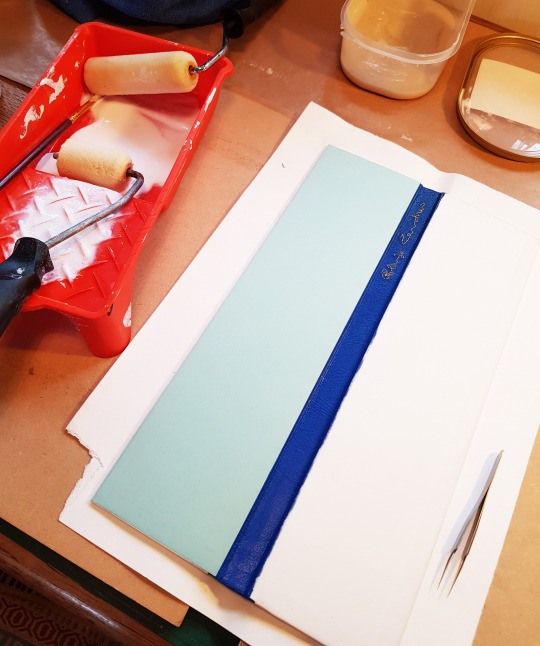
During the process of trimming the pages at the beginning of the project, there were a few off-cuts of paper left over with a little of the pochoir on them. I kept these not knowing whether I would find a use for them.
As the folded concertina wasn’t perfectly square on all four edges (it was seemingly impossible to get it so!), plus with this method of binding there was no need for sewn headbands, I decided to add some of my own. This would neaten up the look of the head and tail of the book and would add some more detail.
I began by cutting two small sections of square profile tulipwood to the width of the inner spine.
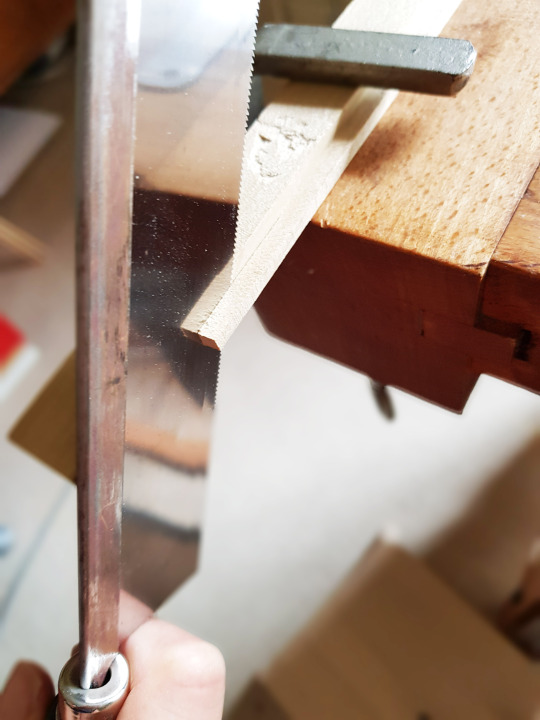
These were then mitred at both ends and paired together with the pochoir offcuts.
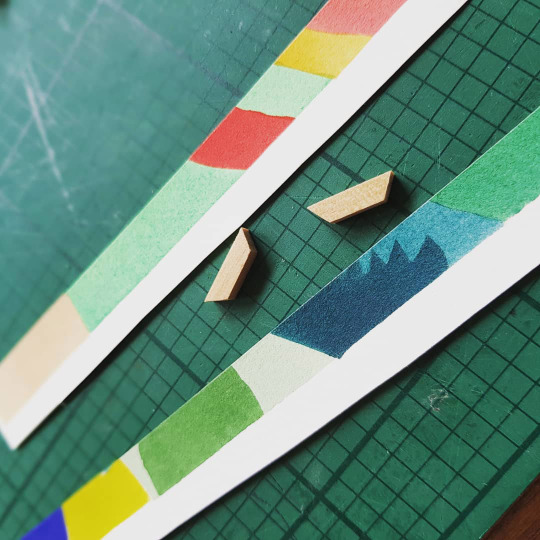
I delaminated the paper so that it was thinner, and covered the tulip wood in the coloured paper. I am now referring to these as “end-caps”.
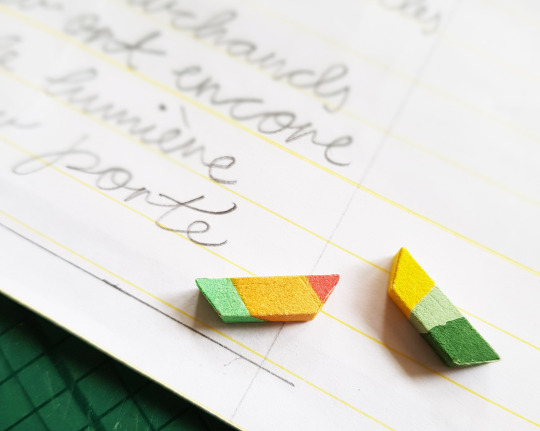
I drilled two holes in both the end-caps and glued two brass pins in place. Corresponding holes were also drilled at the top and bottom of the inside of the spine, and the end-caps were secured in place.
At this point, I also glued the concertina into the case by tipping the tab that was left at the end of the folded concertina directly into the front board of the case, so that when positioned the pages were square.
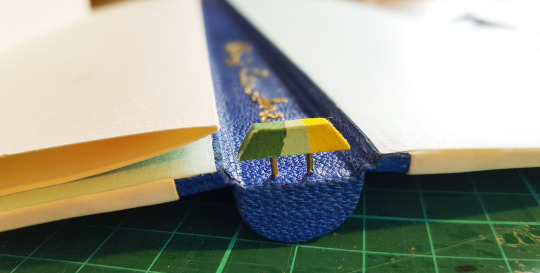
So the book was complete! Now time to move onto the box. I commissioned a wonderful woodworker to make a tulipwood box for me to the following dimensions.

I wanted the title on the front of the box, and to carry the theme along I decided to embroider this onto the box lid. I used a bodkin to mark holes into the surface of the wood through a template, and then used a very fine drill bit in my Dremel to drill through the box lid.
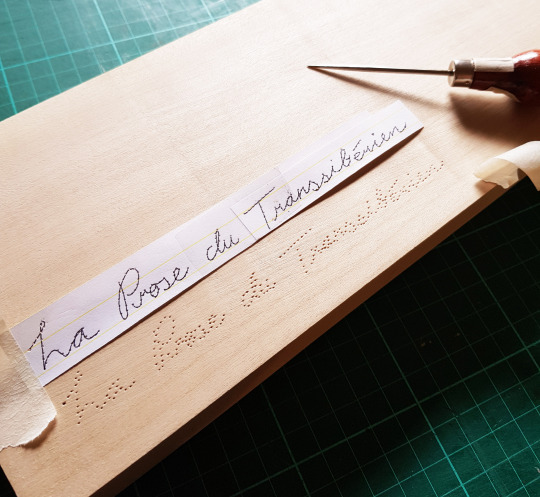
I then used a fine needle and embroidered the title onto the lid in the same way i had done all of the words on the cover, first with a running stitch and then a whipping stitch. It was more difficult to do the whipping on the box top as there was no flexibility in the wood so I had a bit of trouble weaving the needle under the running stitch in places but I got there in the end.
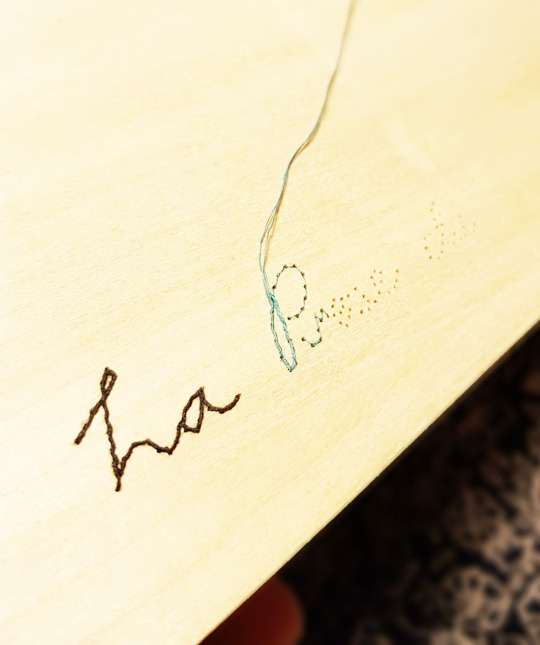
To add a bit of extra colour to the title, I punched out some small circles from the leftover pochoir paper. I also cut a thin circle of wood out of the box top using my Japanese centre punch and then these paper circles were glued into them.
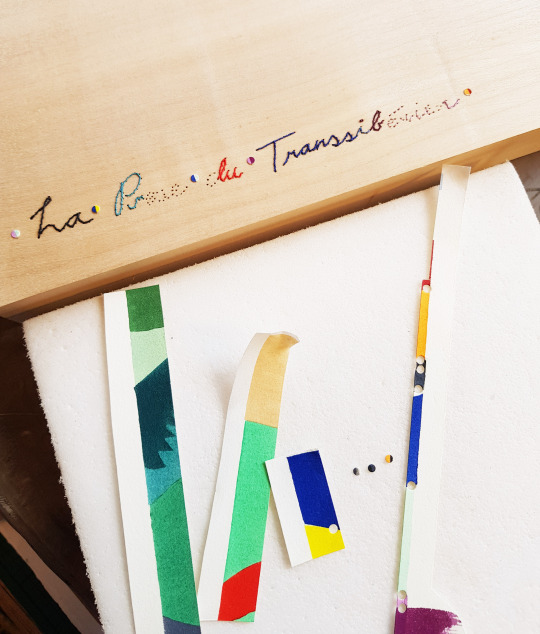
The thread tails were glued down on the inside of the lid. I then lined the inside of the lid and base of the box with felt which absorbed the threads underneath, the sides were lined with matching paper. A ribbon was attached into the bottom of the box to help lift the book out.
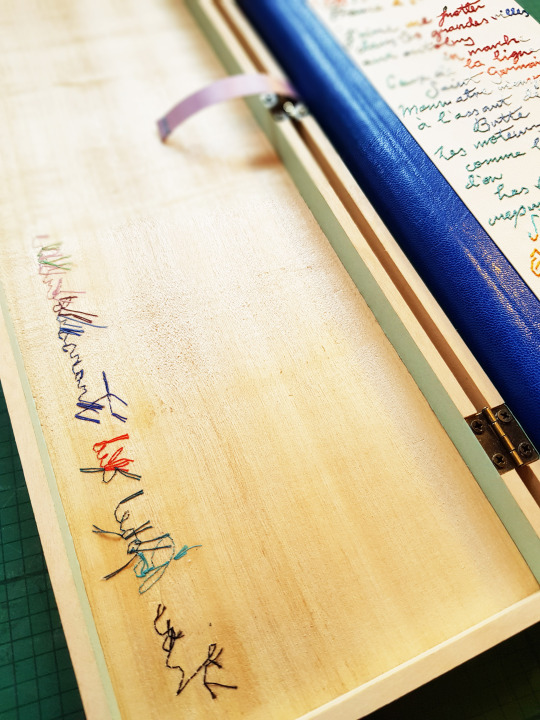
The final blog post shows the completed binding, plus images of the sample board/book I made up to test the process out on, “La Prose Part Five: Finished Binding”.

I marked out the size of the boards on to the back of the vellum. As I didn’t want a cut edge to be visible on the edge of the vellum that would be overlapping the spine leather on the cover, I folded an edge over by about 5mm and glued it down. The plan was to butt this folded edge up with the top paper lamination that was glued to the outside of each of the cover so once glued down this would be flush.

Initially I secured the vellum, face-down, onto a piece of Plaztazote foam, I then pinned the tracing paper template down on top of it in the correct place and pricked through hundreds and hundreds of holes at regular small intervals along the flow of the writing.
The great thing about using the vellum was as it was a lot thinner and stiffer than leather, the pricked holes were really visible once I had made them.
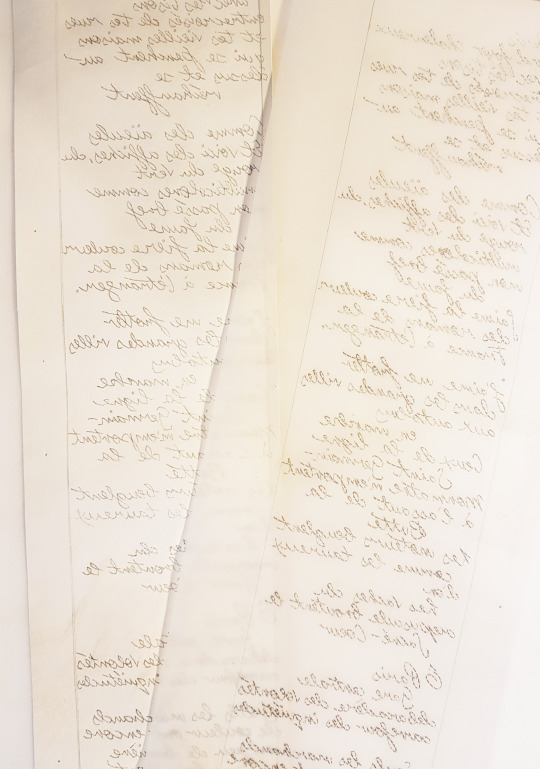
The next arduous task was to remove the tracing paper template and join together the dots making up the the words in reverse (obviously working back to front as this was on the back of the leather - very confusing!) so I knew which direction my embroidered threads needed to go.
The plan from the beginning with the embroidery was to use threads that matched the colours of the pochoir as closely as possible. Having matched these and made a chart on a photocopy the time had come to start the the embroidery process.
Didn’t however just want to use a random selection of the colours for each of the words. I therefore laid down the tracing paper template on top of the actual pochoir, with a layer of glass on top, and worked directly from the colours on this.

I chose different parts of the pochoir the front and back to get the best mix of colours possible.

And so the embroidery could begin! I got comfy and spent the best part of two weeks sewing all of the words in place. I must admit, I did start to wonder why I had set myself such a mammoth task as the hours clocked up…

I made a paper sheath to hold the vellum is as I was working on it. As the pieces were so long and thin I didn’t want the end I wasn’t working on to get dirty or marked in any way. This was held in place using a small bulldog clip.
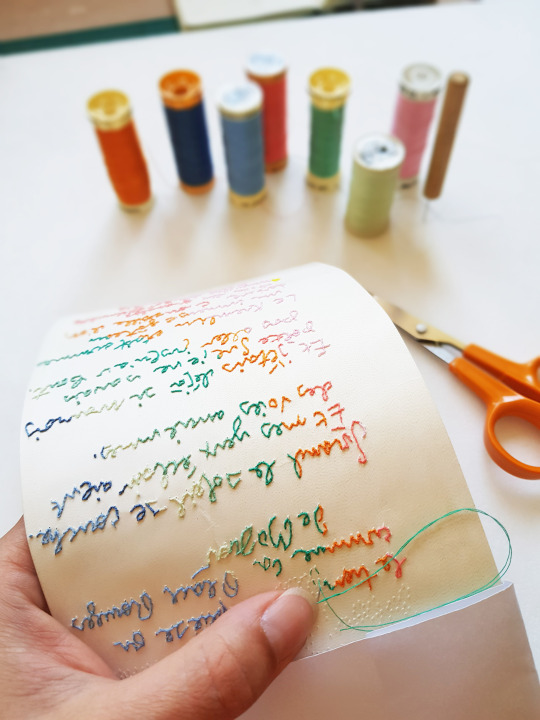
With lots of stitches on the front, of course this results in lots of loose threads on the back. I periodically went along and trimmed these tails and glued them down to the reverse with PVA.
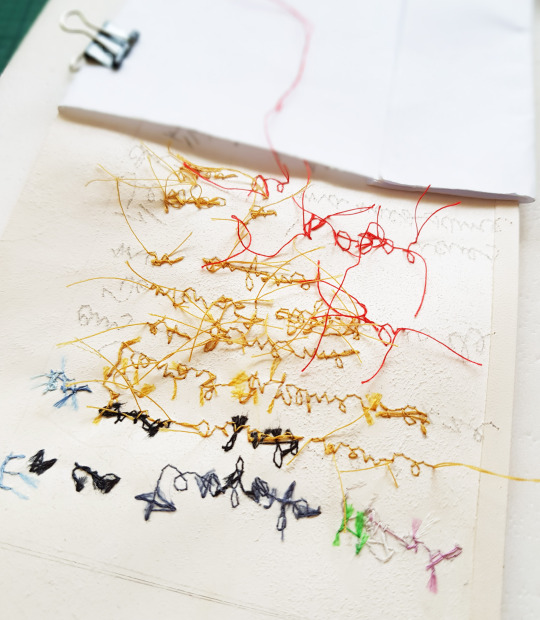
I worked in a few sentences at a time, having the correct colour threads available to me to quickly interchange colours.
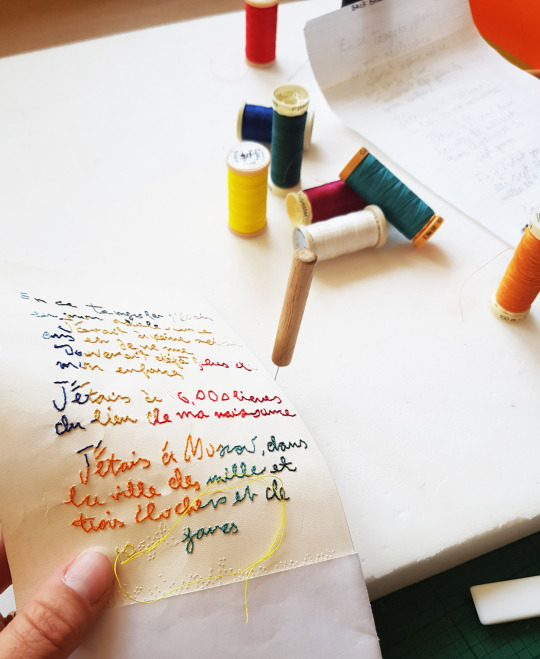
I even stole away some time on a weekend away to do some more sewing: embroidery on tour! Obviously I wasn’t actually driving at the time of taking this photograph…
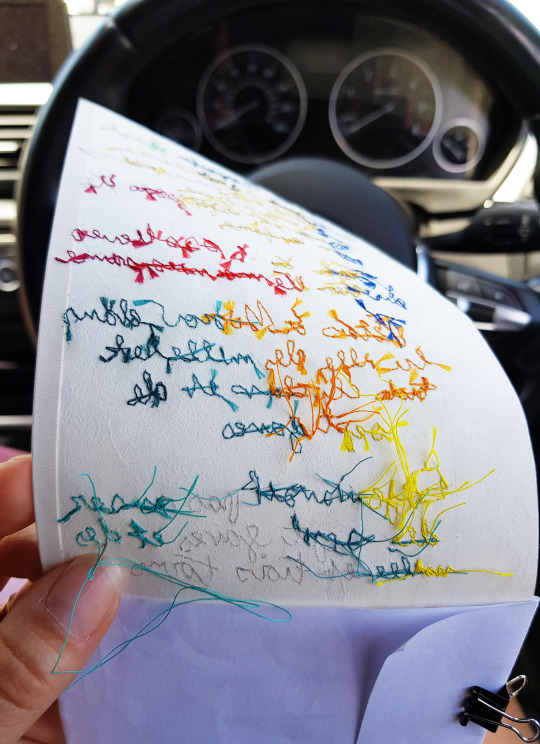
Each word was initially built up by joining the holes with a running stitch, using one strand of embroidery thread. Once the outline of the word was complete I then went around each of the running stitches with a whipping stitch, two strands in thickness.
So eventually all of the words were made up with a whipped running stitch. The needle creating the whipped running stitch did not enter the vellum at all, apart from where it started and finished at the beginning of a word.
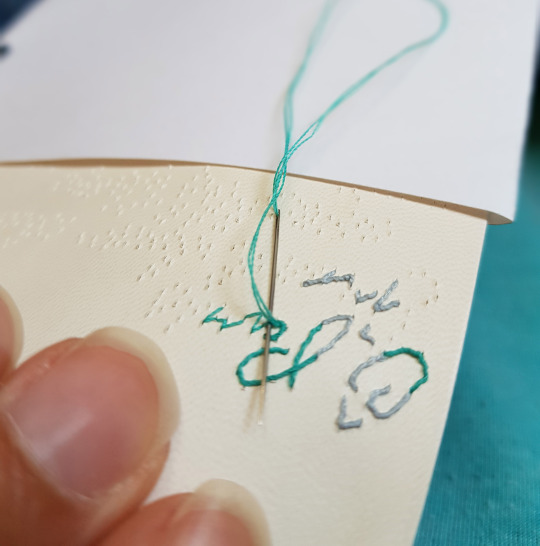
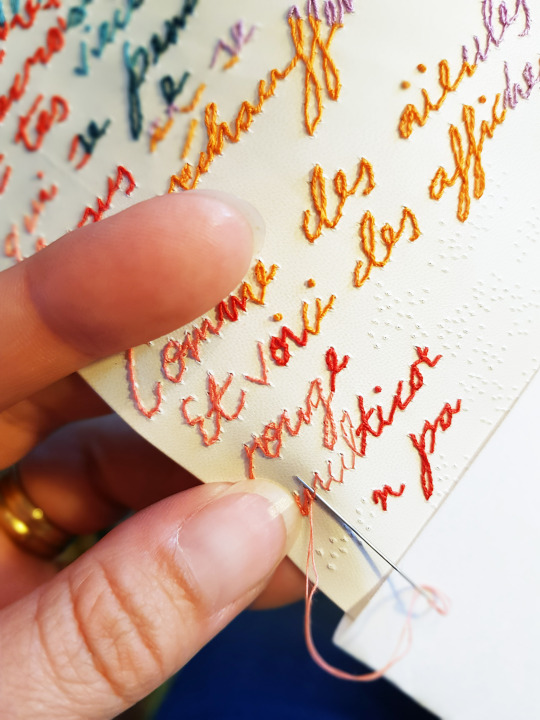
Some sections of the text were more complicated than others, requiring numerous colour thread changes. Whereas some I had quite a bit to do just on one colour. It was more time consuming having the change the threads regularly.

I mentioned previously that I had turned over the cut edge of the vellum. On both the front and back covers, some of the words were placed that they were to be sewn on top of this double thickness. To avoid bulk on the back, I carefully cut away some small channels in the turned over vellum, where the stitches were going to fall on the back, in order to absorb the threads so that this would lie flush once glued to the text block.

I employed a couple of different methods of securing the loose threads down to the reverse of the vellum. Once I had finished with a colour, if there were suitable threads to go through on the reverse, I pushed a needle through behind them, thus securing the tail of the thread and I could cut it off.
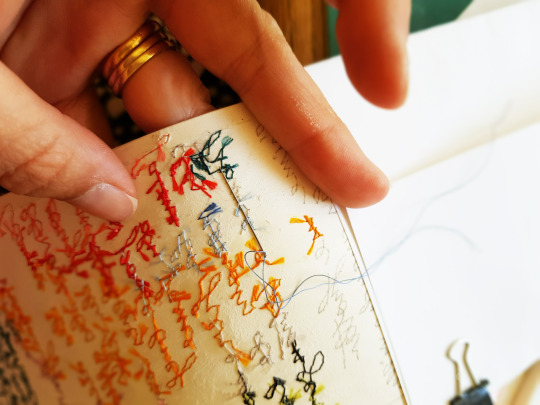
This image shows the completed back embroidery, but with all of the front still to go…!
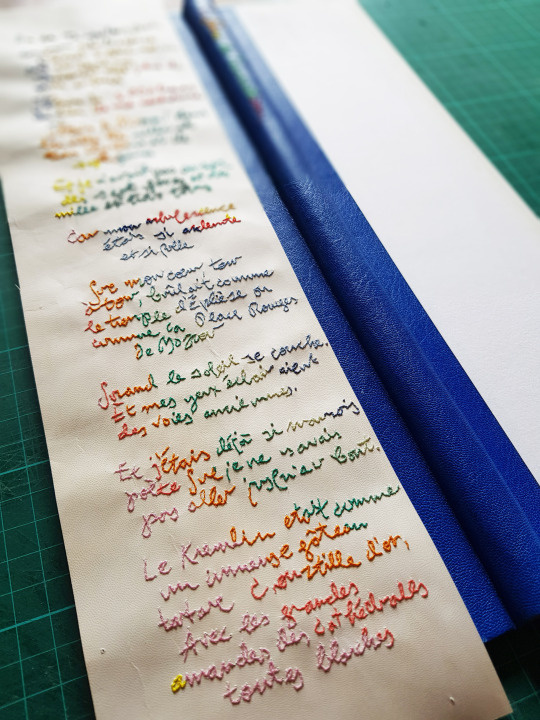
I mainly used Gutermann 100% polyester threads as they gave me the best colour matches. I am really lucky that in the town I live in (Shepton Mallet in Somerset, UK), there is still a haberdashery shop - they are so few and far between these days. It was absolutely key with this project to be able to see the threads in person before buying, matching the colours and buying threads online would have been much more difficult. I carefully packaged up my folded La Prose concertina at the start of the project and walked the ten minutes into town with it, into the haberdashery shop, to see first hand what colours I needed.
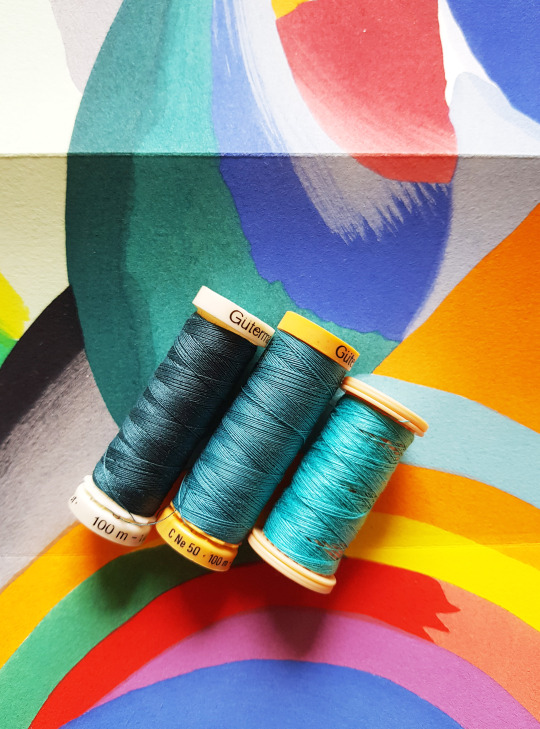
When it came to “dotting all the i’s”, I used two strands of thread. I pushed the needle through from the back and tied it into a loop.

Using the end of my needle pricker, with the very point of the needle placed in the centre of the loop thread against the hole in the vellum, I pulled the knot tight. In doing it like this, the knot tightens down the length of the needle pricker tight to the surface of the vellum creating a neat knot.
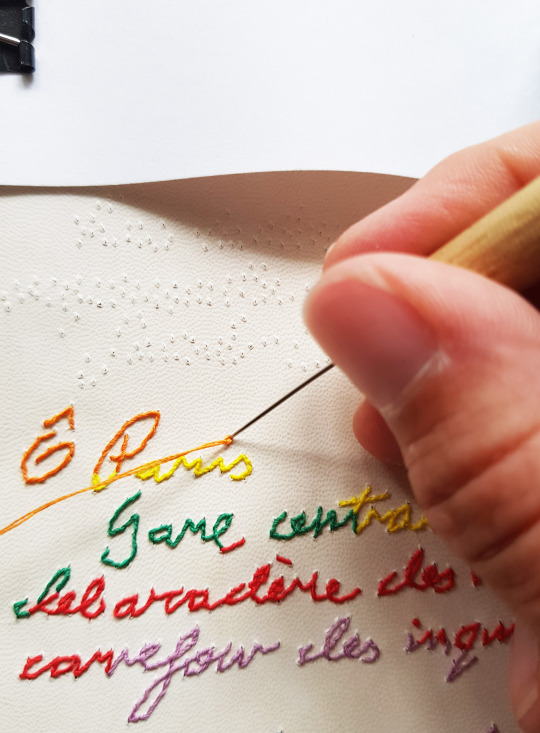
The needle was then pushed back though the vellum, through the same hole that it came out of. As the knot had been tied and there was extra bulk in the thread it wouldn’t pull back through.
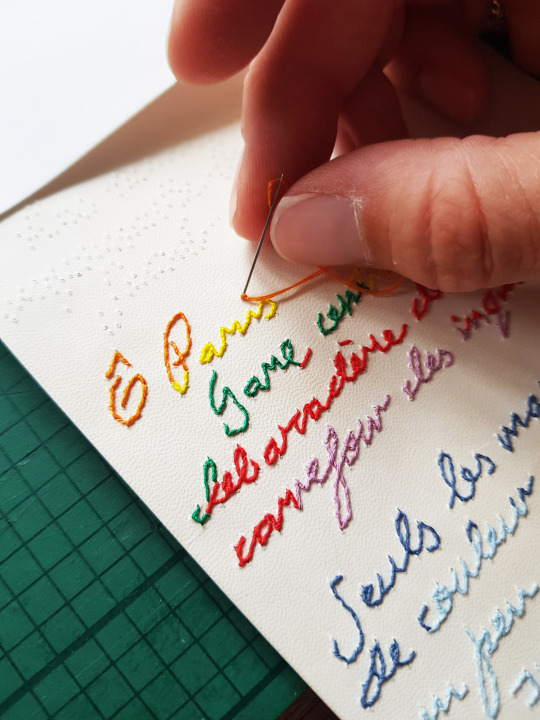
The second method I employed for securing down the thread ends is pictured here. I cut the tail of the threads short and then frayed out the end using my needle pricker. This was then glued down with PVA and rubbed with a teflon folder. The whole way through the process I was aware that I wanted to create as little bulk of thread on the back as possible. As the vellum was so thin in comparison to standard leather I would use for a fine binding, any threads on the back were going to be partly visible and not as absorbed as much into the covering material.
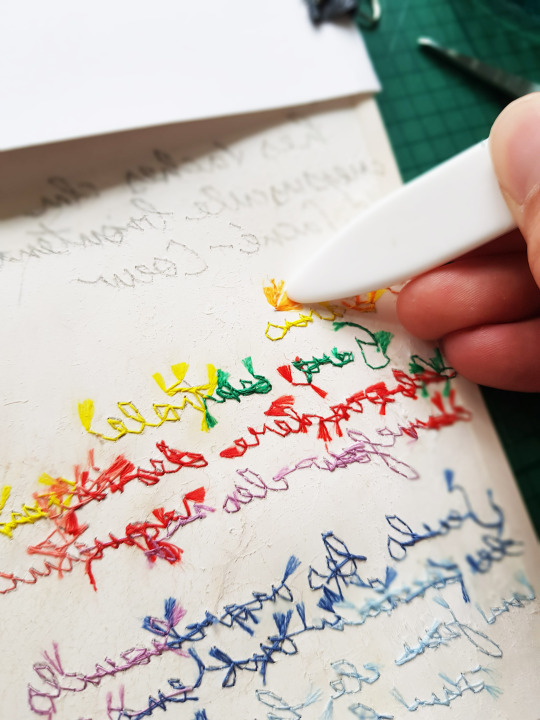
After two weeks of embroidery, the end was nigh!
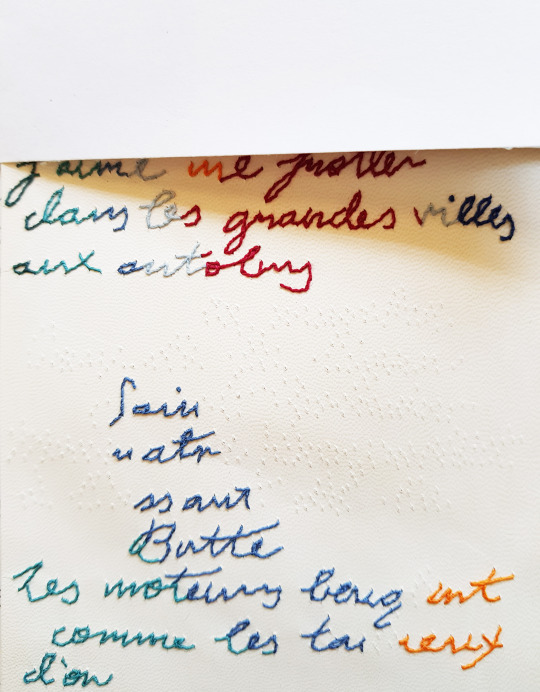
And then I was down to just one word, made up of 43 holes, 42 running stitches, and 21 whipped stitches…I could se the light at the end of this very long embroidery tunnel.
I didn’t count the number of words on the front and back cover, or try and calculate the number of stitches I made, but it would most certainly be in the hundreds of thousands!

The next part of the blog is “La Prose Part Four: Book Covering” and it details how I got the vellum onto the boards.
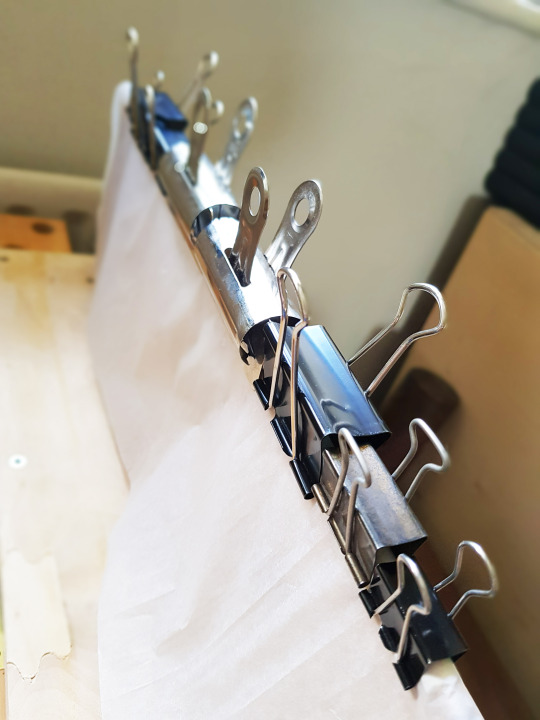
With this binding came a number of challenges. Having overcome the gluing and folding of the beautifully printed sheets, how was I actually gong to bind them? I had never bound a concertina book before so this was going to be a first.
From the very beginning my thought was to create a false round spine which I would attach the boards to and the concertina would be attached inside it somehow. I wasn’t able to tell how the Paul Bonet version had been bound from the image I had seen but guessed this would have been done using a similar approach.
For each of the fine bindings I do I work on a sample board beforehand to test out ideas, colours, threads etc. For this binding, given I was unsure of the binding structure too I decided I make a mini version of the binding, the size of my usual sample boards. Photos of that will appear at the end of the run of these blog posts but that is what I used to test out the binding method of the full-size book.
I started off with a half-round wooden dowel, the dowel was 15mm across but I needed to build this up to 20mm across to allow for the thickness of all the folded pages, plus a bit extra. I stuck the flat edge of the wooden dowel to the edge of a pressing board with double sided tape (so I could remove it again!) and put the board into a laying press. I cut a piece of 300gsm watercolour paper to size, glued it up and then positioned it on the round of the wooden dowel. I held it in place by covering it in a layer of silicone release paper and holding this down using a series of bulldog clips (pictured above).
This was repeated five times, and then I glued a layer of Aerolinen on top (slightly shorter than the length of the spine) followed by a piece of Zerkall.

Once dry I sanded the spine to get rid of any lumps and bumps. I had already laminated up the boards using two layers of 1mm Gemini board, with a layer of archival Kraft on the inside. Further laminations were to be glued on the outside of the boards once I had joined the spine piece to them.
I glued the Aerolinen to the boards with an equal space at the front and back to allow for the leather joints to be stuck in at a later stage. The boards were then lined on the outside with a layer of card to the same thickness as the Aerolinen.
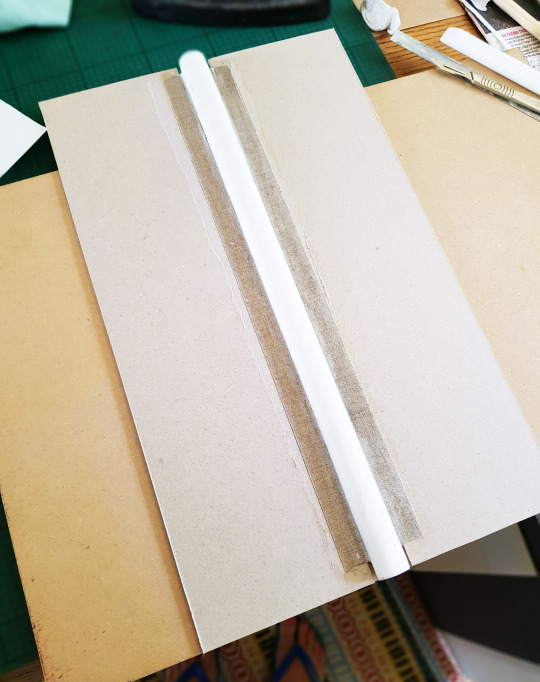
The end of the false spine was “capped” with a piece of Zerkall cut to the same shape.
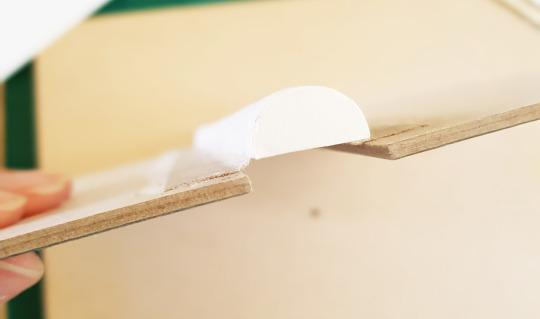
Once the book cover had reached this stage I was able to work on covering the spine with leather. I pared some blue Harmatan goatskin to about 0.4mm in thickness and thinned the leather more along where the board joints were going to be.
As I knew the covers were going to be entirely embroidered, I wanted to also embroider the title on the spine too. I made a pricking template of the book title and laid this down in reverse on the back of the spine leather centrally. I pricked through with a needle pricker and then joined the dots so I had lines to work from with the embroidery.

I laid the title writing down over one section of the pochoir colours and worked my way along changing the thread colour at the point where the pochoir colour also changed.

It resulted in a multicoloured title on the spine. The stitches were each done using a running stitch. Once the word was complete I ran around each of the individual stitches with a whipping stitch to make them cleaner and sharper.

Once this embroidery was complete it was time to stick the leather to the spine. I thinned out the very ends of the leather that were going to be turned over the spine ends, applied a mix of paste and PVA and then stuck the leather down. I had scrap boards of the right thickness held in between the front and back boards to keep them perpendicular to one another during the covering process.

The leather was then turned down onto the spine ends (I cut out some wedges of the leather first to rid some of the bulk) and inside the boards. Once dry I filled in the semi-circular void with a small piece of leather of the same thickness and sanded the whole lot flat. This was then capped with a thinly pared piece of the same blue leather.

The inside of the spine received similar treatment. I wanted to incorporate a left-handed signature I had found of Blaise Cendrar’s so decided to embroider this on the piece of leather that was going to cover the inside of the spine - a little surprise to find when opening up the final binding! This was embroidered in metallic gold thread. This was pricked through the leather in the same way as the spine title.
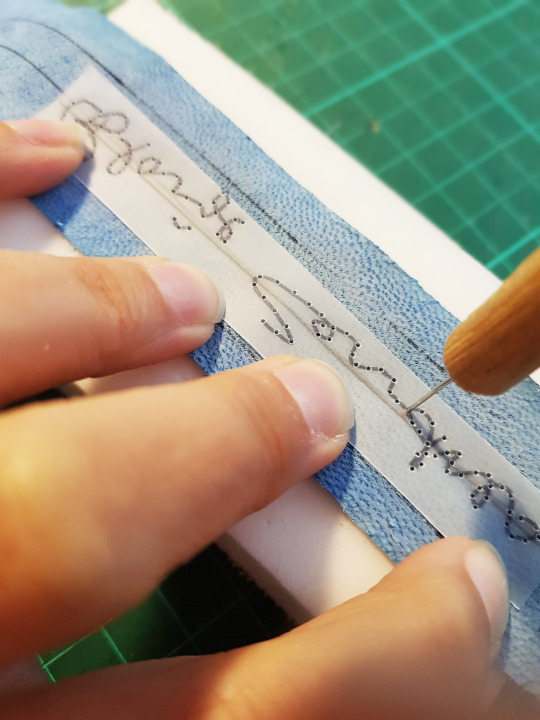
The edges of this strip of leather were pared very thin so that when the piece was stuck down the edges formed a thin layer of leather over the inside board joints.
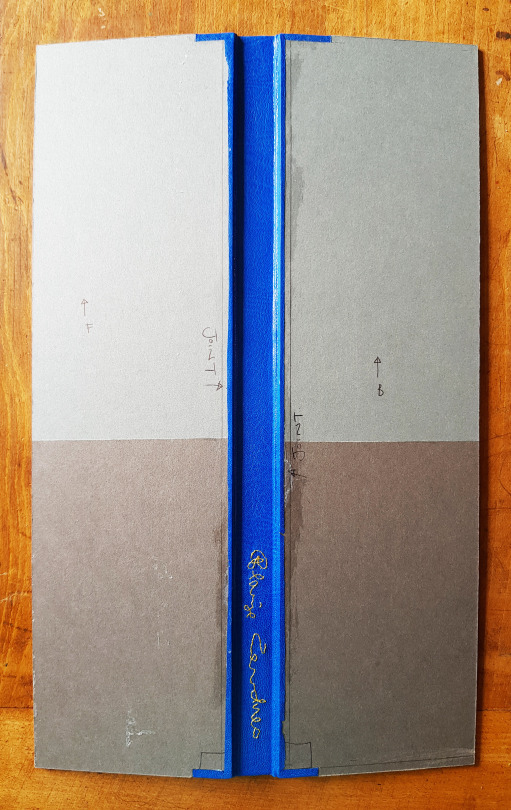
A piece of watercolour paper was butted up to the edge of the spine leather and a piece stuck to the front and back boards. The watercolour paper and the leather were the same thickness resulting in a uniform thickness across the joint that they met.
Some thinner layers of card were then stuck on top of this, overlapping the joint of the leather and the watercolour paper underneath by about 5mm.
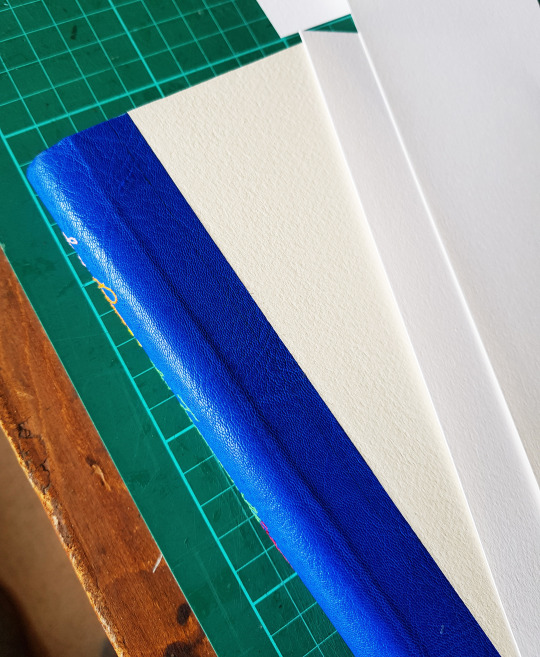
As layers started to get stuck together I thought it was important to make a diagram of what was going on within the laminations, in order to remember in case I wanted to repeat the process again!
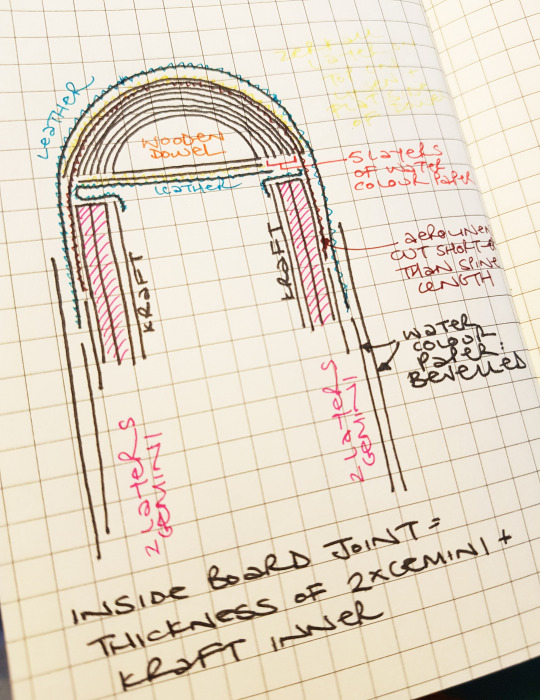
I had left the width of the boards over-long just to be on the safe side. Once the spine was covered in leather it was possible to put the folded concertina in place to find out where I needed to trim the boards to to get an even square.
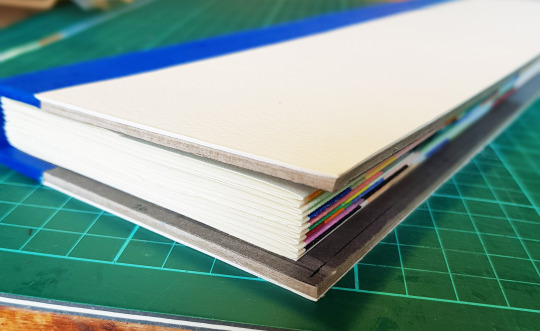
Finally, the boards were bevelled using a palm sander and then some sandpaper around a wooden block. The below image shows the difference in the thickness of the edges of the boards before and after the bevelling process. The thinner sanded edges on the left look more refined than the chunky ones on the right.

I wasn’t sure what material to use for covering the boards at first. Initially I thought I would like to use suede, however when I tried to embroider the words onto this it wasn’t very clear to see as the texture of the surface was too fluffy.
I had a lovely small vellum skin that I bought at the Society of Bookbinders Conference about 10 years ago that had been sat in my plan chest since then. It turned out to be the perfect size for this binding, plus it was very clear to see the embroidered writing and the prick-holes I made through the template were clearly visible on the surface. My only reservation was I had never used vellum before, I had no idea how it was going to react when glued but there is a first time for everything and that is what the sample board/book was for - to test unknowns like this out!

Once I had identified the covering material, I took a photocopy of part of the pochoir and cut small lengths of the appropriate coloured threads I had found/bought to make sure I had a corresponding one for each colour. I cut a little off the end of each reel and stuck to the photocopy.
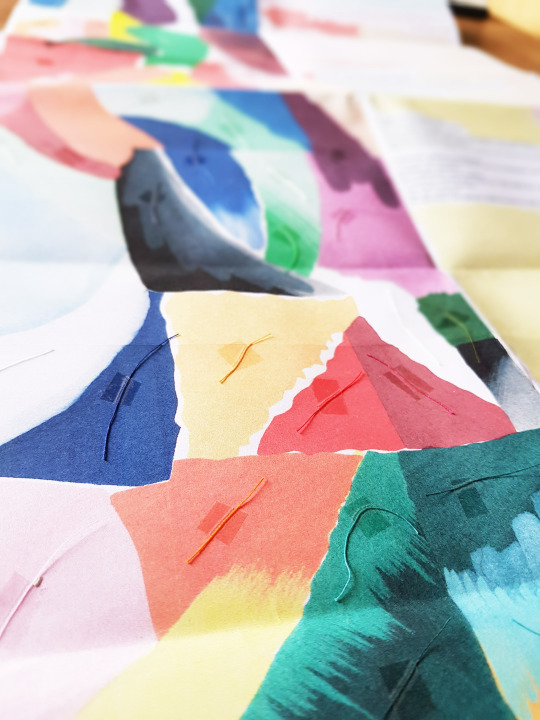
The next blog post will explain how I got the below writing templates onto the vellum covering material and I will take you through the colourful embroidery process. The next post is titled “La Prose Part Three: Embroidery”.
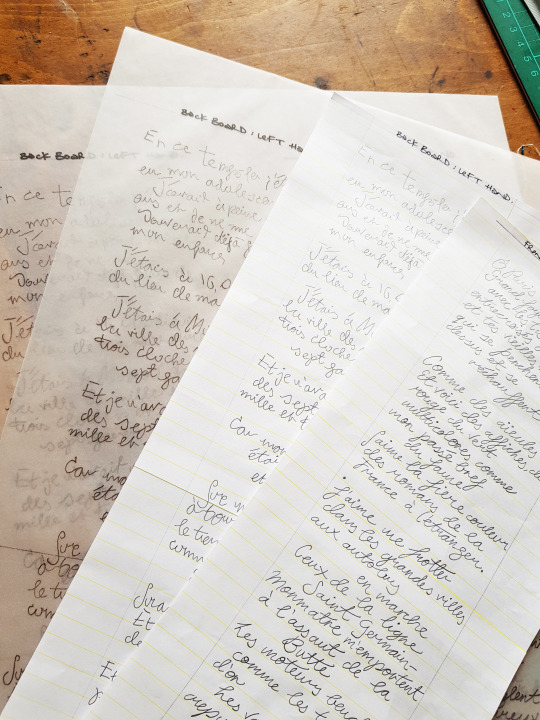
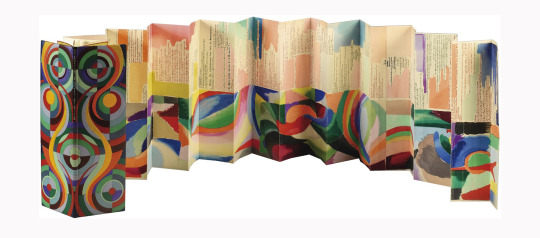
What an exciting project I have been involved in through my most recent bookbinding commission: the recreation of La Prose du Transsbérien et de la Petite Jehanne de France -the remarkable book by poet Blaise Cendrars and artist Sonia Delaunay. Sonia and Blaise first met in January of 1913 and formed an instant friendship, producing this book by letterpress and pochoir in 1913. The original book was a landmark achievement for its time and remains vibrant and modern today.
The recreation project was conceived by Kitty Maryatt, the proprietor of Two Hands Press in Playa Vista, California since 1974. In 2017 she decided to publish the recreation with the help of underwriters. Kitty has created a blog of her own documenting her journey through the process of recreating 150 editions as closely as possible to the original book by using letterpress and pochoir. Her blog is totally fascinating can be found here. It is thanks to this blog, plus some additional information that was printed to be housed with the completed book, that I am able to pass on so much information about this latest binding of mine.
The image above shows the binding made by Paul Bonet between 1963-64, sold by Christie’s in Paris on April 29, 2004 for 350,000 Euros. Sonia and Blaise had planned on making 150 copies however this was not completed.
“Was the primary reason for the incomplete edition the excessive length of time it might take to complete the pochoir process, assuming that the pochoir was the final procedure before binding? Did World War I intervene? Were there exhibits of the book, any reviews, any publicity at all? Were the sales disappointing? Did they run out of money?”
The actual number remains unknown, 74 have been identified but the list of these has never been published.
“The edition numbering system Blaise Cendrars used is somewhat random, indicating that the edition numbers were not written on the copies when they were first made. For example, there are two copies numbered 47, two numbered 111, and two numbered 139. Many copies do not have an edition number. There is a copy numbered 1 and one numbered 150.”
The La Prose of 1913 was printed on three materials: vellum, Japon and simile Japon, they stuck to the typical formula of publishing a deluxe edition and regular edition. Japon in one of many Japanese papers sold by the Japan Paper Company; simili Japon is made with Western fibres, also sold by the Japan Paper Company. The Paul Bonet binding is one of the vellum editions.
The below image shows Kitty’s recreation (right) alongside an original copy at The Getty Research Institute, Los Angeles, CA (left). This is #124, glued and folded into 21 panels, inscribed to Archipenko, the vellum cover is not attached.
“The book itself is captivating with its colorful and painterly pochoir (French-style stencil), so unlike stenciled copies of artwork at the time. The colors seep from the painted side into the poem on the other side.”
Kitty wanted to recreate the pochoir methods as closely as possible to the original using pommes (short, wide brushes) and metal stencil plates. Pochoir is a refined stencil-based technique employed to create prints or to add colour to pre-existing prints. It was most popular from the late 19th century through the 1930’s with its center of activity in Paris. Numerous stencils were designed as a means of reproducing an image. (Photo courtesy of Kitty Maryatt)
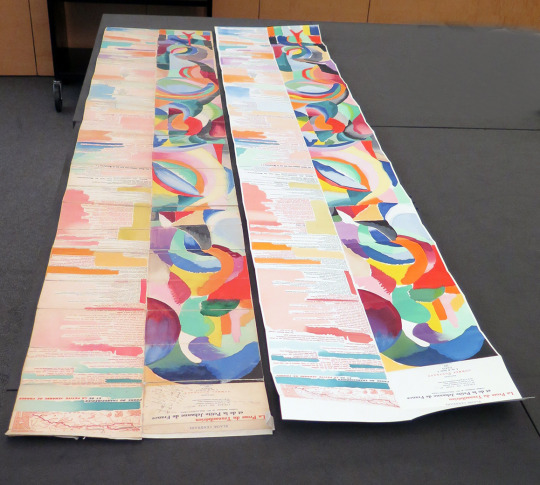
My copy was one of two that Neale Albert (New York) had underwritten and commissioned. When I received my copy of the sheets in the post (#58 0f 150) they came with three different instruction sheets of how the pages could be folded - it was rather daunting!
The long vertical format of the book was an unprecedented choice for a book of the period:
“The Trans-Siberian Railroad was begun in 1890 when Blaise Cendrars was only three years old, but it was highlighted at the 1900 Exposition Universelle in Paris that he attended with his family. The entire series of railroad lines weren’t actually completed until three years after La Prose du Transsbérien was published. In the book, Blaise included a map of the journey from Moscow to Vlasivostok, which gives us a clue as to the distinctive folding scheme of the book. I’ve found tourist maps of Paris for the period similarly folded, in half first, and then in accordion – folded flat and glued to the cover. In the case of La Prose, as you open the book, you can’t actually see anything in the book, neither the text nor the imagery, until the book is completely unfolded.”
It was up to me to choose which format I wished to use having been instructed that there was no set way of binding the book, so total creative freedom! Along with the written instructions, Kitty also sent all binders images of the folding and gluing process - crucial information to have before proceeding. There were three ways of folding the concertina, either like the original (left hand format), long and thin like the Paul Bonet binding (middle format) or double width (right hand format). (Photo courtesy of Kitty Maryatt)
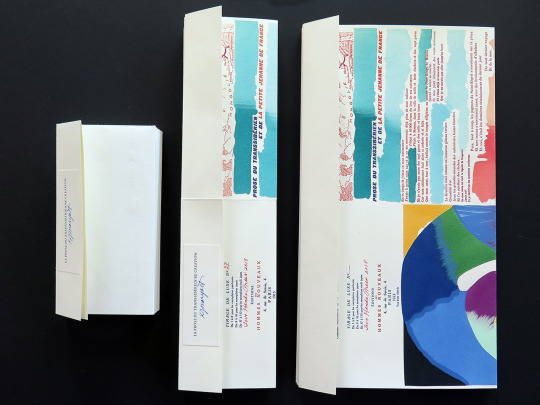
The 1913 edition book covers were painted in oils by Sonia Delaunay, some covers had a snap, which made the book resemble a purse. Kitty’s version of La Prose is bound with vellum covers however she used acrylic paint to decorate the cover as she found that the oils yellowed the vellum. The book is housed in an acrylic slipcase and is pictured below. (Photo courtesy of Kitty Maryatt)
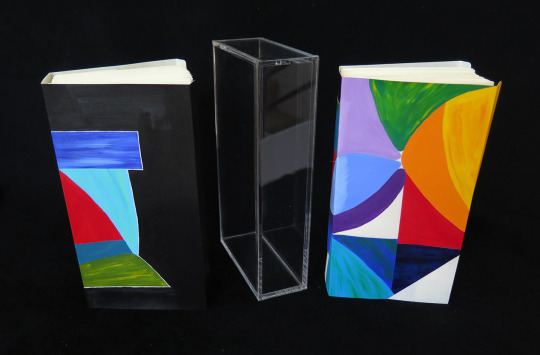
So, the time had come to trim and stick all of my sheets together!
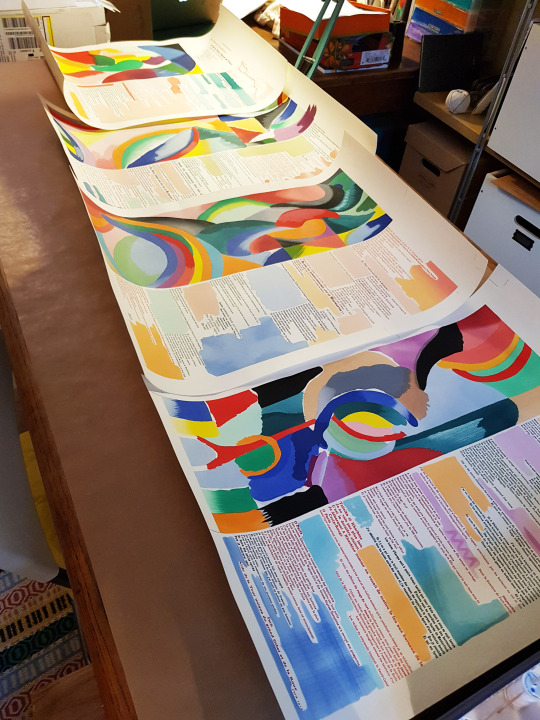
The first step was to cut all four pages to size. I am used to working in cm, I have almost never used inches, so the fact that all of the instructions were in imperial took extra brain power - I never even glance at the other side of the ruler!
The first step was to measure 7 1/18 inches from the centre fold mark at the top and bottom and to cut off one vertical side.

The next was to cut off the other vertical side so that the width of the page was 14 1/14 inches and the two sides were parallel.
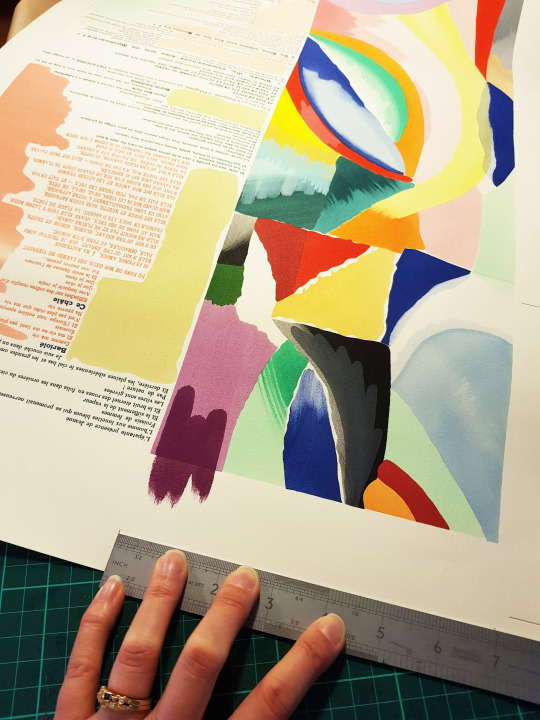
Next I had to cut off one inch at the top of page one, and to trim the top of pages 2 to 4 at the printed mark on the right side just above the first line of type. The bottoms of each page then had to be cut to meet the following lengths: Page 1 - 21.75 inches, Page 2 - 20.25 inches, Page 3 - 19.875 inches and Page 4 - 19.5 inches.
I was then able to proceed with gluing all four sheets together. I soon found I didn’t have a long enough table to work on but managed to get around that by moving two next to each other! The cut edges of the sheet were not thinned or pared in any way, they were stuck together at full thickness (the same as with the original binding).
Pages one and two were lined up along their edges, overlapping by ¾ inch. Each page was glued to about ½ inch in, so that when overlapped all of the paper overlap was covered in glue. The reverse of the upper page was glued, then the front of the lower page before being combined.
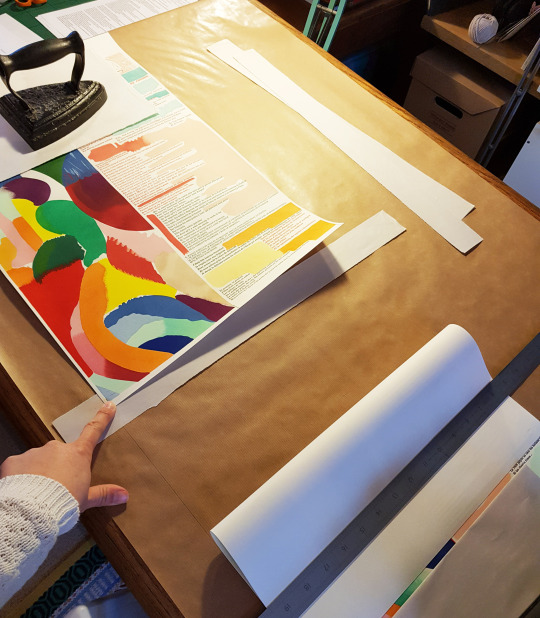
A weight was applied to the glued joint afterwards and I waited for it to dry before moving on to gluing the next joints. The instructions stated:
“Note that the images don’t line up completely at the joints. I copied the original exactly. Why did they do that? It’s odd from our perspective. The outside lines should line up pretty well if you cut to size carefully.”
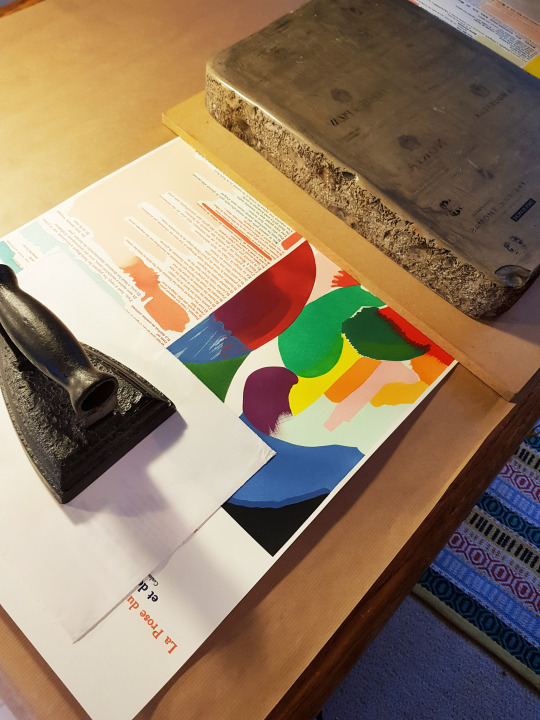
Once all four sheets were glued together is was time to start folding. Her the instructions did actually switch to being in centimetres!
“Folding: I use a jig of board cut to 197mm. I place the board on to the paper at the bottom edge, blank side up, place the ruler next to the left side of the board, remove the board, and score the paper 197mm from the bottom edge, and fold up. The next fold is 197mm from the first fold, I score on the blank side and reverse the fold (or you can flip the book if you wish). Continue until you get to the top, where you will have a tab left for attaching to your binding, if you wish.”
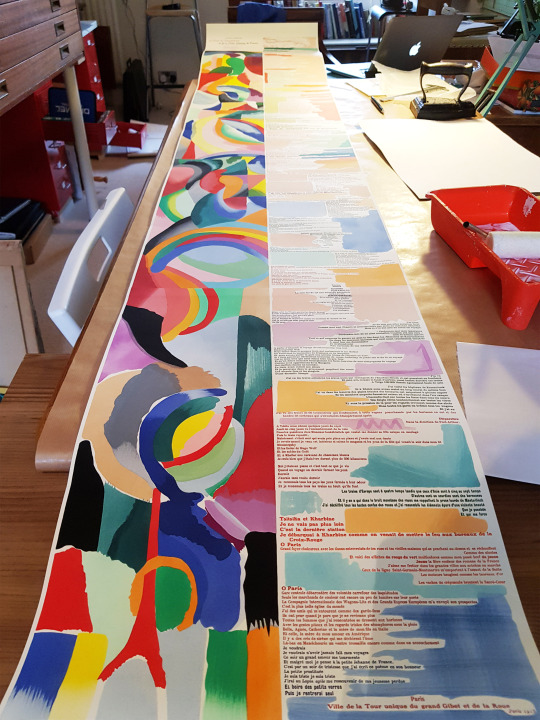
These folding instructions left me with a text block to the largest format possible. I deliberated for a long while whether to keep it at this size, but in the end took the plunge and did an additional fold in each section to give me a text block that was half the width, so the same format as that of the Paul Bonet binding.
Once I had the text block size it was time to start designing the cover. I knew that I wanted to use embroidery, as I always do, so set about making sure I had threads to match all of the wonderful pochoir colours.

I decided to do some research into Blaise Cendrars. Blaise Cendrars was the pen-name for Fréderic Louis Sauser - a play on Braise (ember) and Cendres (ash). He was a Swiss-born novelist and poet who became a naturalised French citizen in 1916. He was a writer of considerable influence in the European modernist movement.
His writing career was interrupted by World War I, he was sent to the front line in the Somme from mid-December 1914 until February 1915. It was during the attacks in Champagne in September 1915 that Cendrars lost his right arm and was discharged from the army.
As he was right-handed, he had to learn how to write with his left hand following the war. I decided to try and find handwriting examples of his from before and after he lost his right arm which was possible online. It would have been wishful thinking to find a handwritten transcript of La Prose, however I did find some good examples of both his left and right handwriting on other documents.
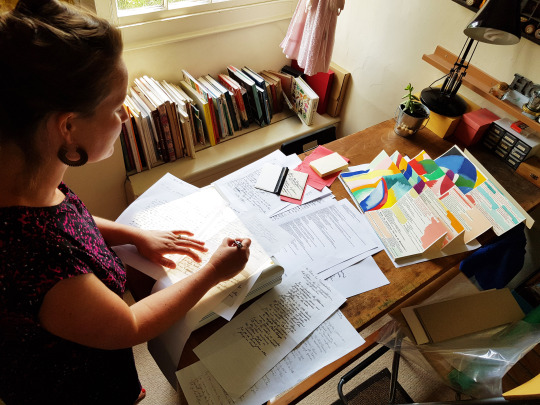
What I decided to do was to transcribe parts of the poem in each of these handwriting styles to use on the front and back of the book. I used a typed print out of the poem to refer to and found example of whole words (if possible), or individual letters, from the documents I had found, and pieced these together to try and reflect the writing style of before and after the loss of his arm - the left hand writing was more haphazard and scribbly-looking. What I couldn’t work out at first though was which should go on which cover!
I put the question to some family and friends and got some great feedback. What I hadn’t thought about before was that if I did the “before” handwriting on the front and the “after” handwriting on the back, when the book was opened up or laid flat I would have the writing on the sides which naturally correspond to the hands which were used - the decision was made.

So the “after” left handwriting became the design for the back board, and I took wording from the beginning of the poem.
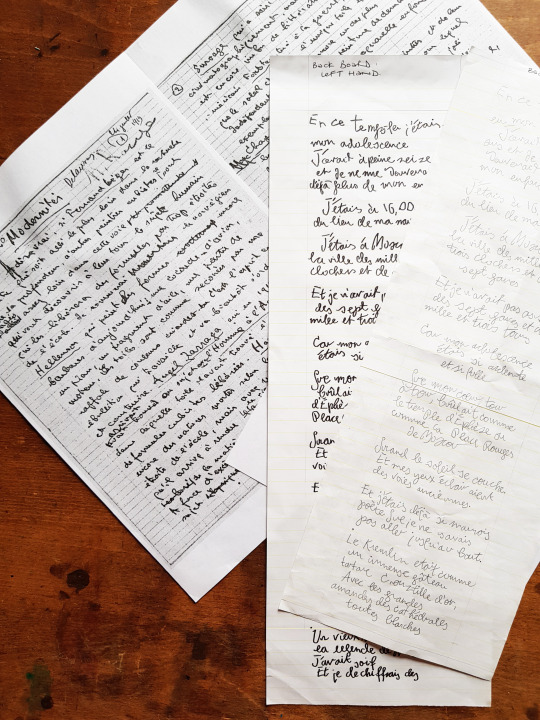
And the “before” right handwriting became the design for the back board, and I took wording from towards the end of the poem.
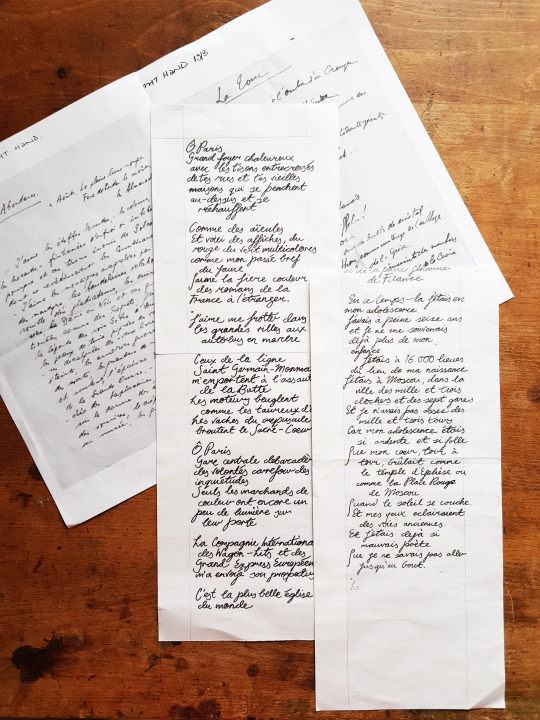
It took a few attempts to get it to the right width for the boards, and to get enough words on so that the front and back covers started and ended at the same heights. For each of the covers I photocopied the writing onto tracing paper templates so I had a master copy to work from.
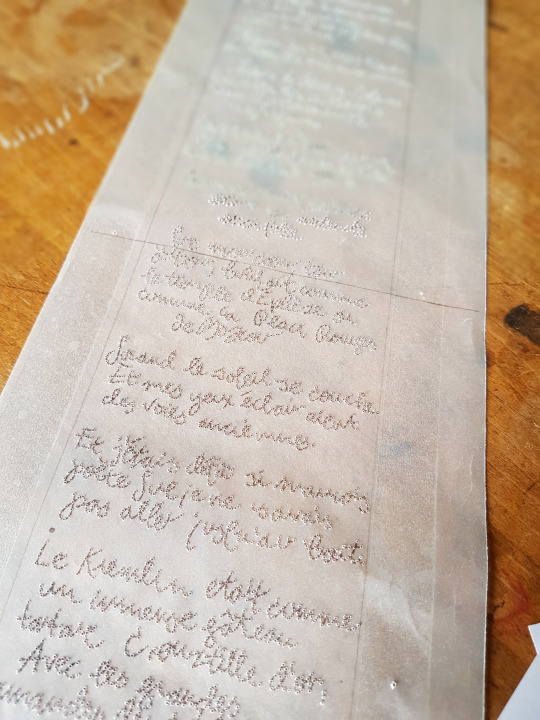
During the period of time I was working on this binding I made a trip to London to see the British Library’s exhibition entitled, Writing: Making Your Mark.
“Writing: Making Your Mark is a landmark British Library exhibition, which spans 5,000 years across the globe, exploring one of humankind’s greatest achievements – the act of writing. From carved stone inscriptions, medieval manuscripts and early printed works to beautiful calligraphy, iconic fonts and emojis, Writing: Making Your Mark (26 April – 27 August 2019) will deconstruct the act of writing and consider its future in the digital age.”
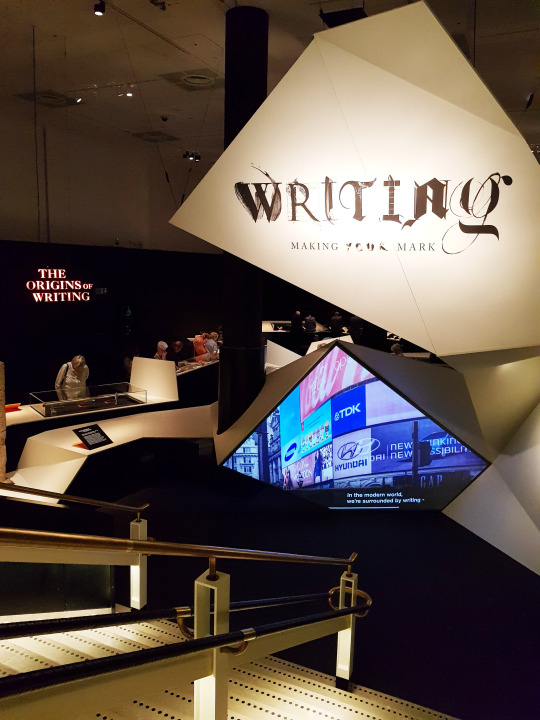
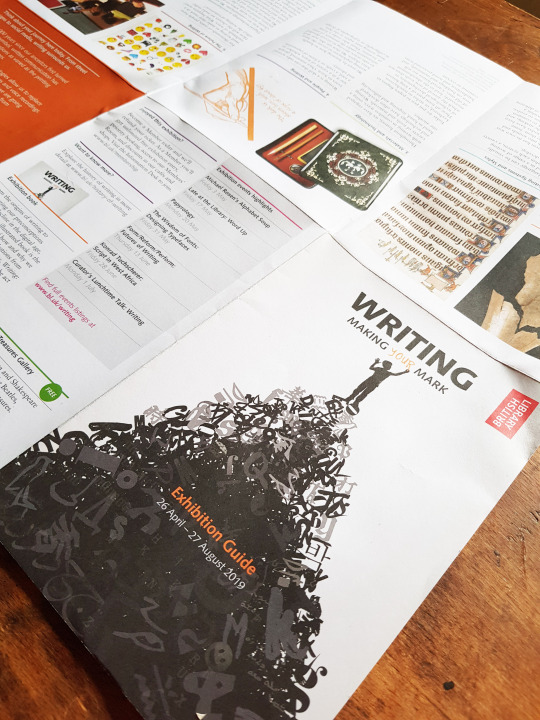
What a timely exhibition to be on whilst I was making my own mark with the handwriting of Blaise Cendrars.
“People first created writing 5000 years ago, its invention revolutionised society. Writing began in a number of locations around the world, at different times and for different reasons. People developed it to communicate across time and space, carrying it with them as they traded, migrated and conquered.”
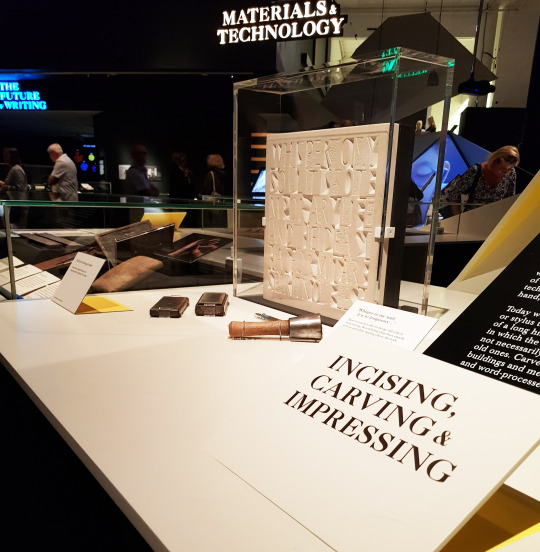
It is amazing to think that writing and technology have often developed hand in hand. What began as inscribed patterns on bones thousands of years ago has somehow led to me sitting at my computer typing away at this blog on a keyboard. I hope I have done Blaise Cendrar’s two versions of handwriting justice in my binding!
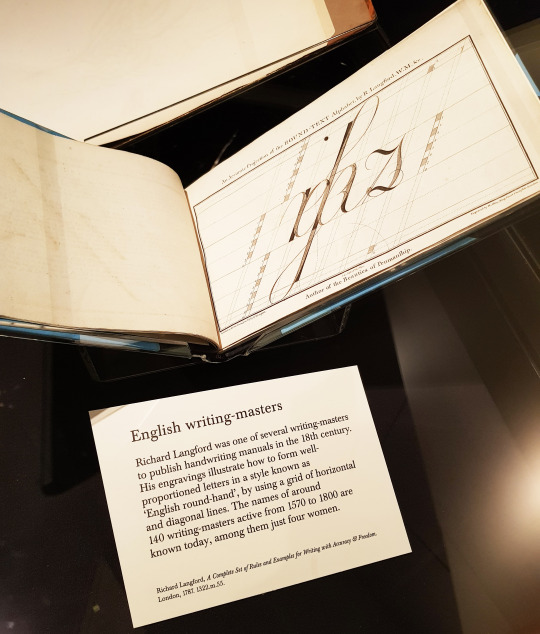
In August 2015 Kitty identified thirty-eight distinct typefaces used in La Prose.
“Blaise Cendrars printed La Prose at Imprimerie Crété in Corbeil, France because he was already in the process of printing his second book, Séquences, at Crété in early 1913. The poem is four hundred and forty-five lines long. In a brilliant and groundbreaking master stroke, Blaise decided to select dozens of typefaces for the poem.”
She was convinced that Blaise did not walk along the hundreds of type cabinets at Crété impulsively selecting type: Crété certainly would have had an in-house type catalogue to view the available typefaces.

The next blog post will go through the choices I made when it came to binding such a book, “La Prose Part Two: Structure”.
COLOR SHE-RO
Love everything she created….
Sonia Delaunay (14 November 1885 – 5 December 1979) was a Ukrainian-born Russian artist, who formally trained in Russia and Germany and spent most of her working life in Paris. She co-founded the Orphismart movement, noted for its use of strong colors and geometric shapes . Check out some of her films below and most of all listen to Mile Davis Sketches of Spain.

Post link
ArtistSonia Delaunay (1885-1979) is considered a French artist but she was born Sonia Illinitchna Stern in Odessa, Ukraine. Raised later in St. Petersburg, Russia, her childhood memories of Ukraine remained with her and she often referred back to the ‘pure’ colour and bright costumes of the Ukrainian peasant weddings. These two images are pochoir on paper from her folio Tapis et Tissus(Carpets and Fabrics), written and designed by her in 1929 and in our special collections.
Post link

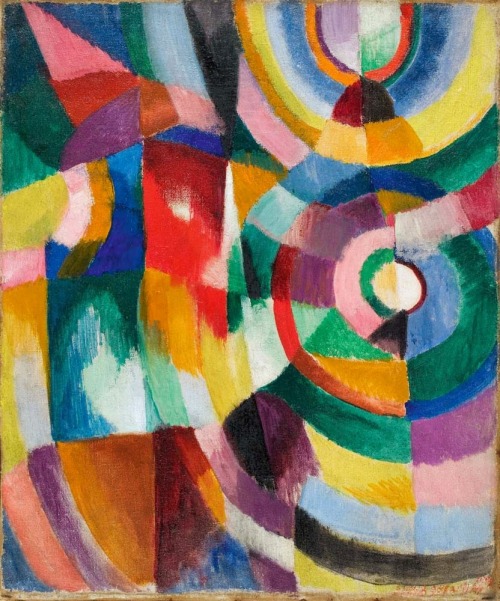


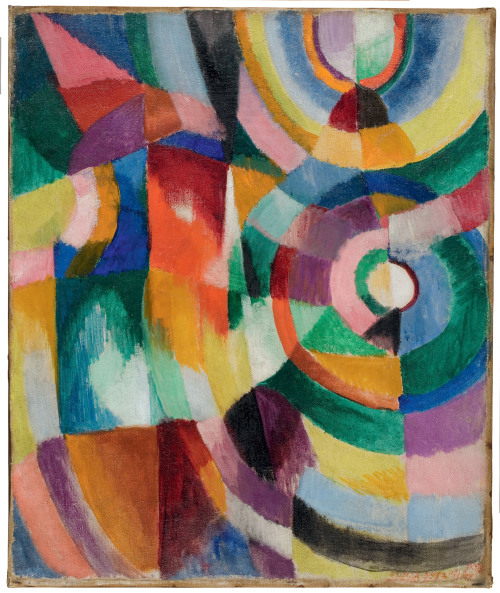




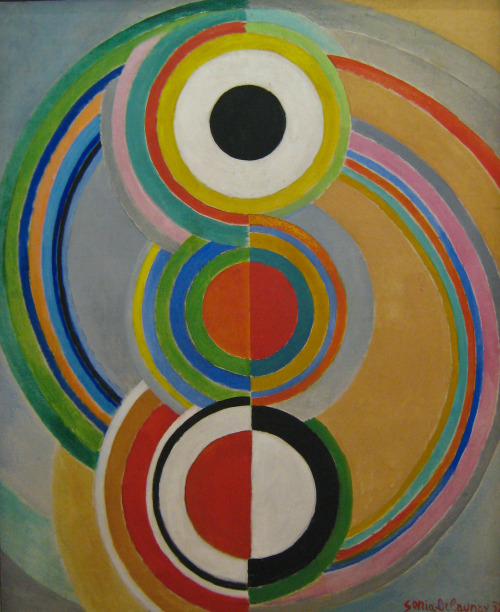
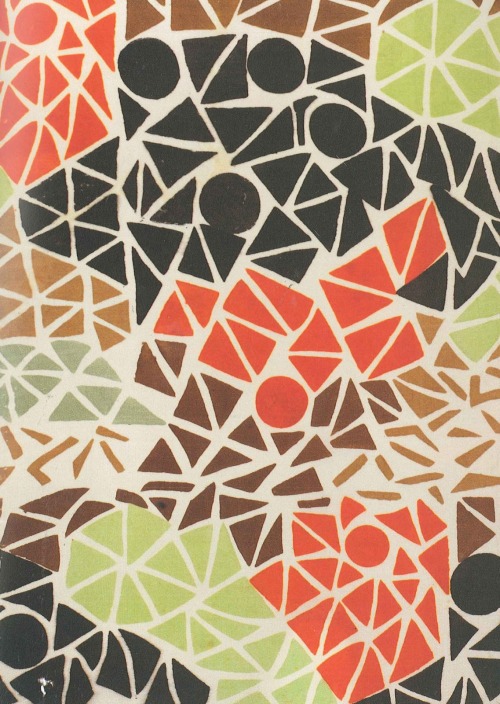
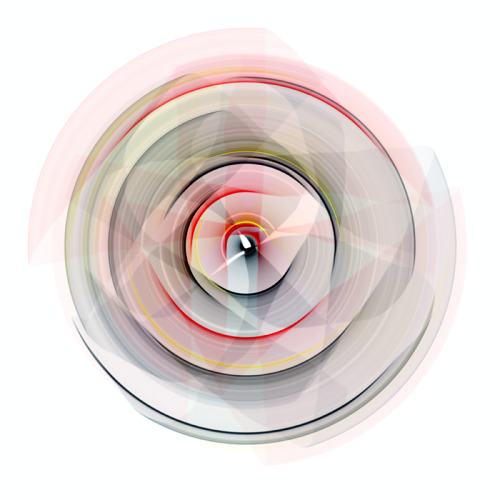
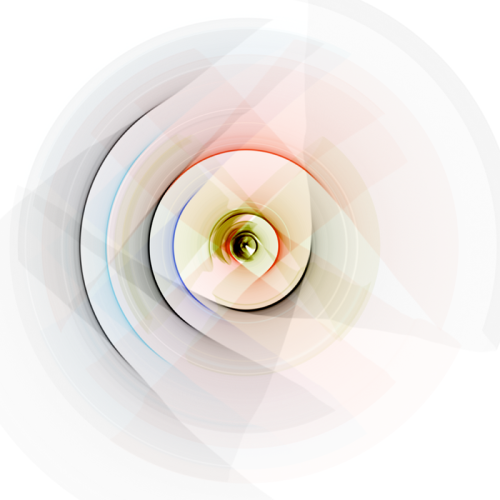

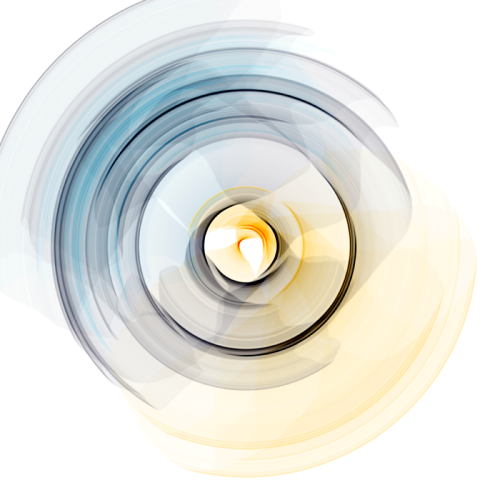



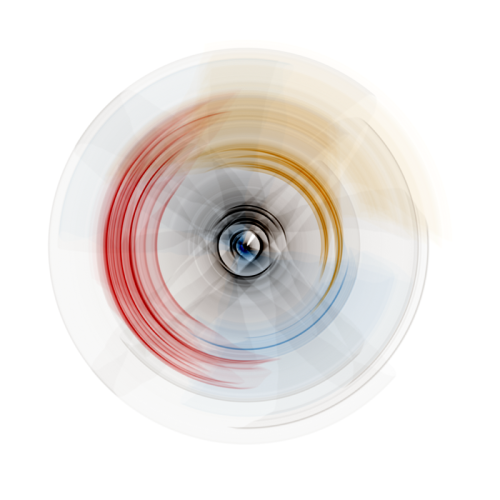
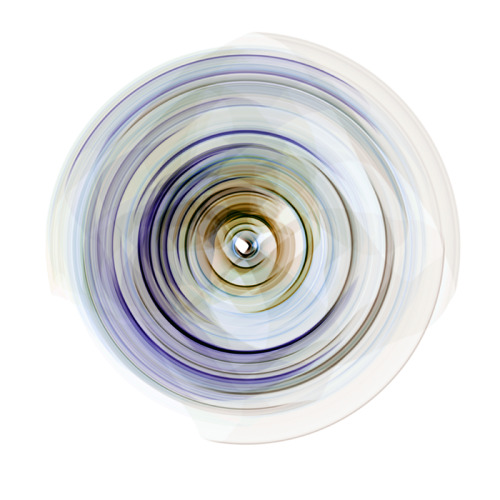

![Sonia Delaunay. Rythme, [1938] by Gandalf’s Gallery on Flickr. Sonia Delaunay. Rythme, [1938] by Gandalf’s Gallery on Flickr.](https://64.media.tumblr.com/4ff07810d6d5d61fcd7ef902565935e2/tumblr_oo1s0q3kp21rdwik4o1_500.jpg)
